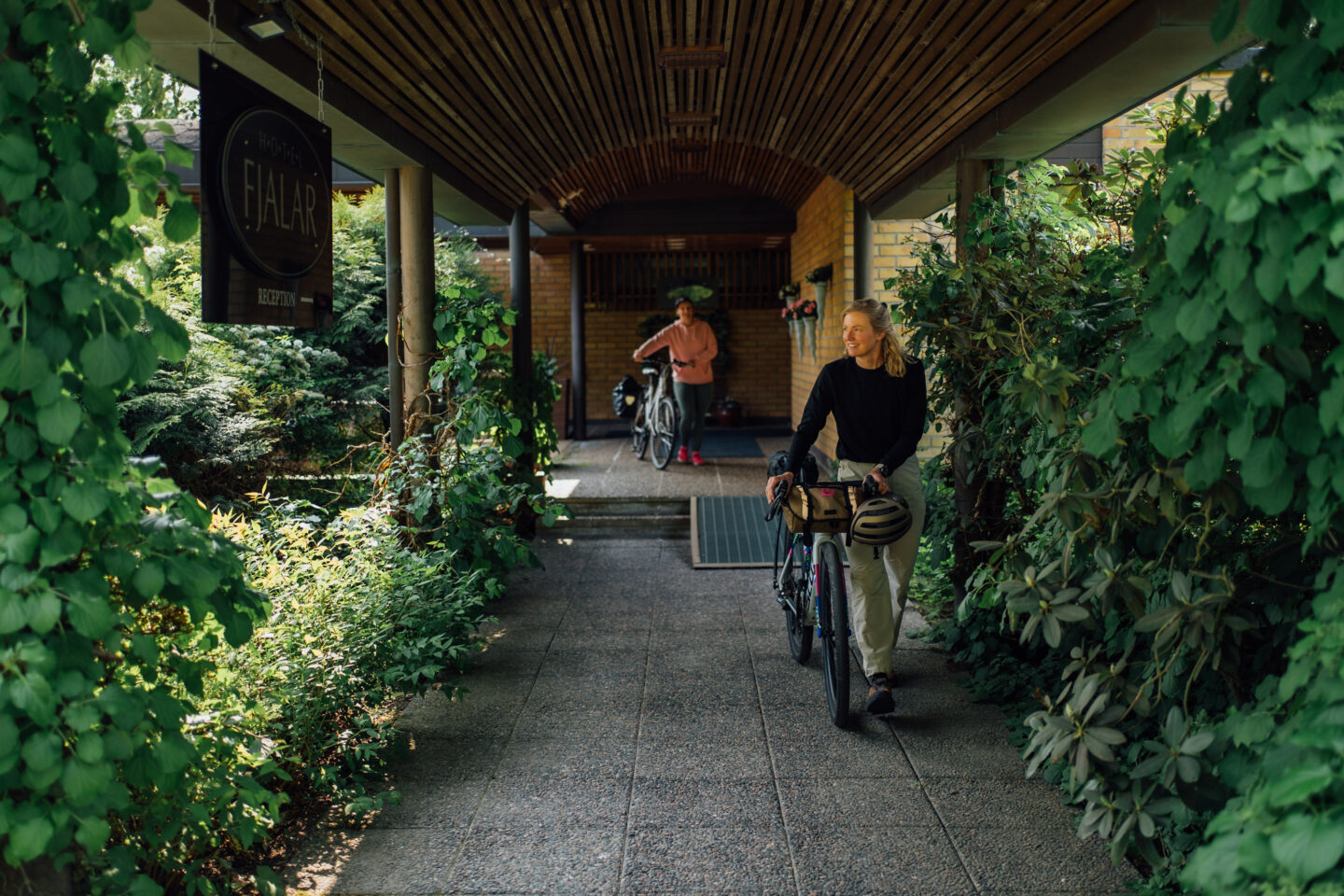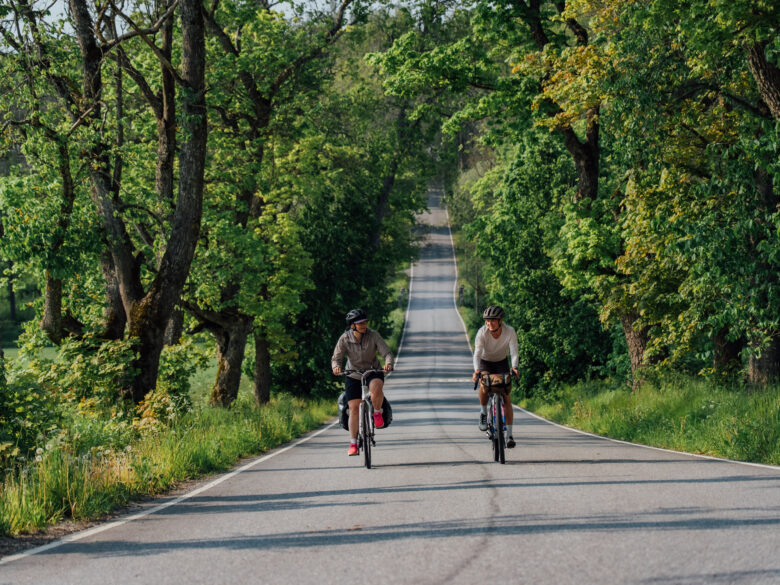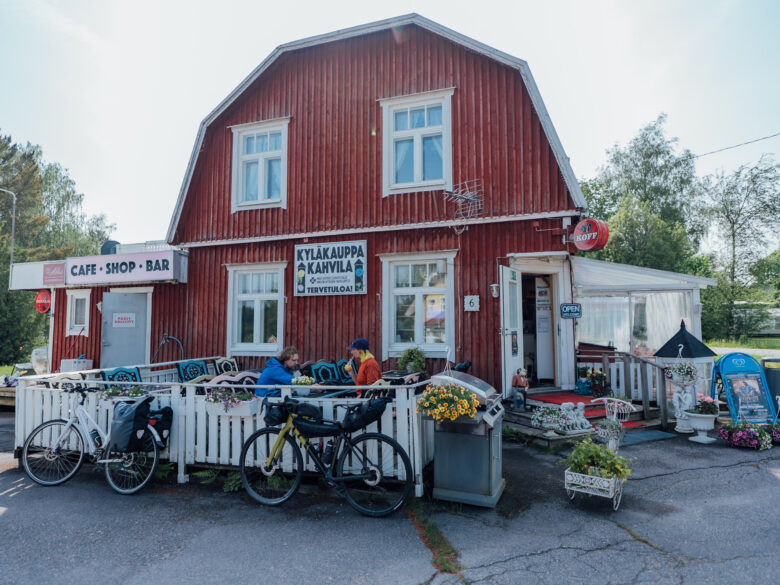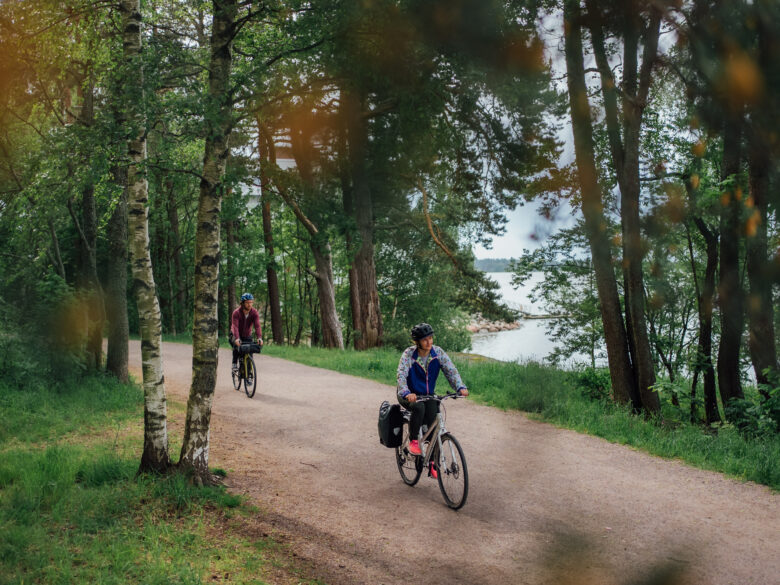EuroVelo 10 Turku to Helsinki
 284 km
284 km 3-7 days
3-7 days 2229m
2229m 69m
69m 5 %
5 % 0 %
0 % 1
1 100 %
100 %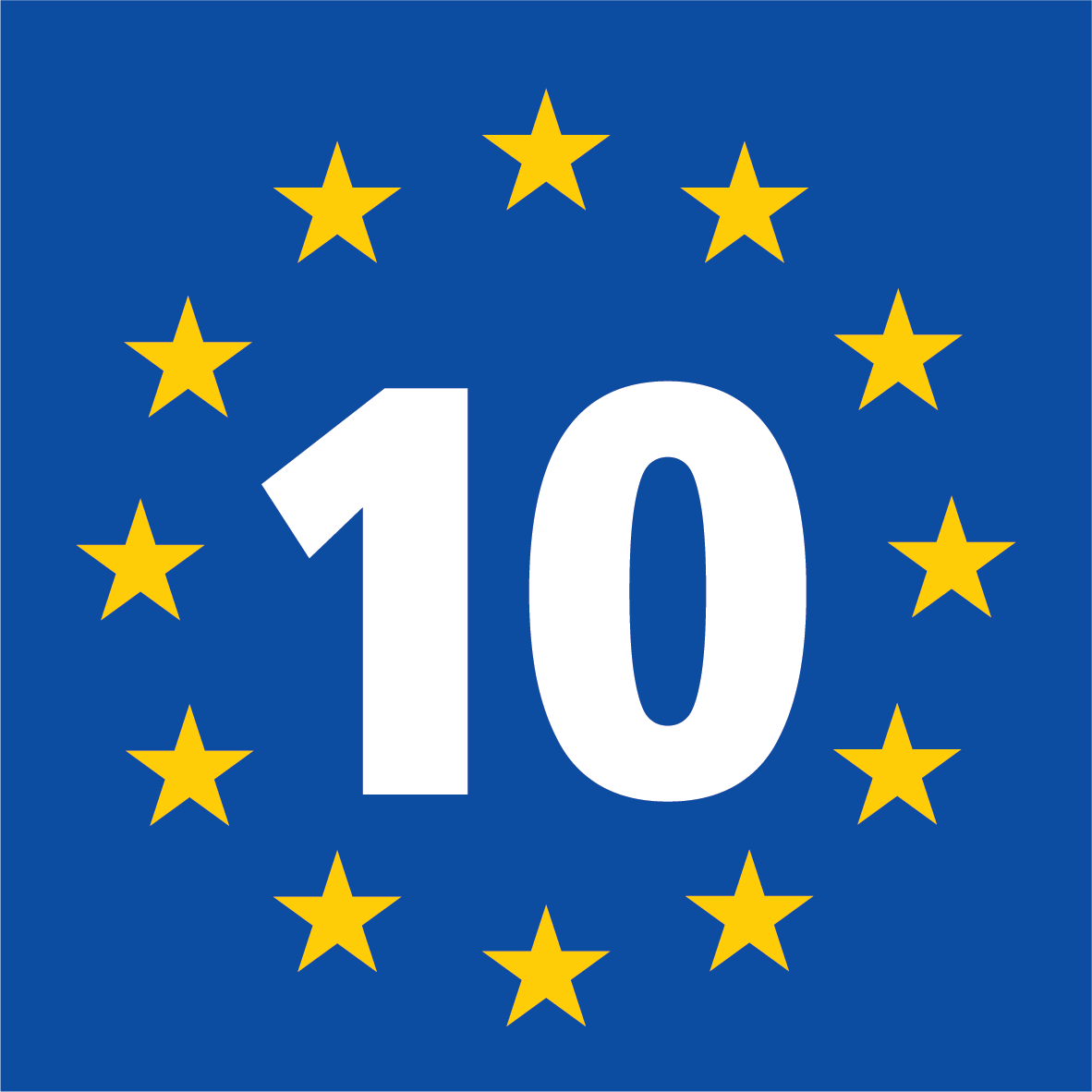
The Turku–Helsinki section of the EuroVelo 10 route takes you through a diverse landscape, from coastal towns and quiet countryside to vibrant urban areas, offering an authentic glimpse into southern Finland’s character. The route is divided into seven daily stages suitable for casual cyclists, but it is also engaging for experienced riders who can combine one or two stages at a time. If you are short on time or want to ride only selected sections, you can combine cycling with a train or bus ride to focus on your favorite parts of the route.
The route begins in the historic city of Turku, where medieval landmarks and riverside cafés soon transition into quiet country roads, pine forests, and traditional ironworks villages. Quiet asphalt and gravel roads guide you through traditional villages and landscapes shaped by centuries of agriculture. History and culture of the area plays a subtle but fascinating role—seen in places like the Alvar Aalto-designed Paimio Sanatorium and the beautifully preserved ironworks such as Mathildedal and Fagervik. These landmarks, along with small museums and village cafés, pace your ride nicely.
The route offers a mix of gentle flats and rolling hills, with a combination of paved and well-maintained gravel roads. Small bumps and potholes add character without making the ride too difficult for less experienced cyclists. Stops for food and rest are placed regularly making the travel pleasant but yet rarely enough keeping the journey peaceful and relaxing. The route’s coastal identity is best felt at the coastal towns and villages like for example the historic town of Ekenäs, with its charming wooden buildings.
As you approach the Helsinki region, you experience how nature stays present even when you are in the capital of Finland. Bike paths lead you through Espoo’s archipelago parkways, and into the capital itself—where seaside cafés and busy market squares await.
From Helsinki, you can continue your journey eastward along EuroVelo 10 toward the old town of Porvoo and all the way to Vaalimaa, or take a ferry to Sweden or Estonia. However, since the Russian border is currently closed, it is recommended to use the ferry connections.
Along the route you can also access multiple local cycling routes which you can find from Bikeland route map.
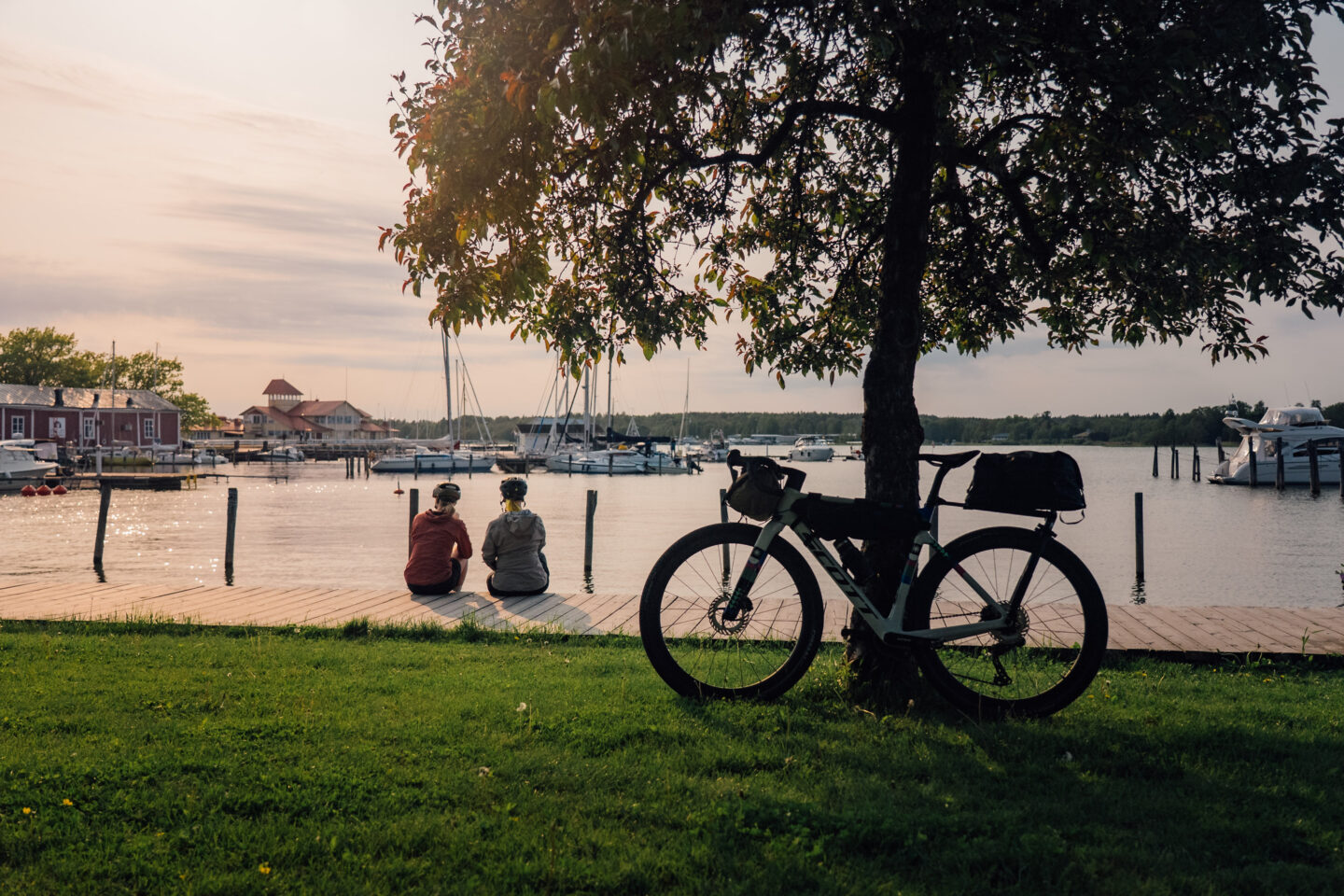
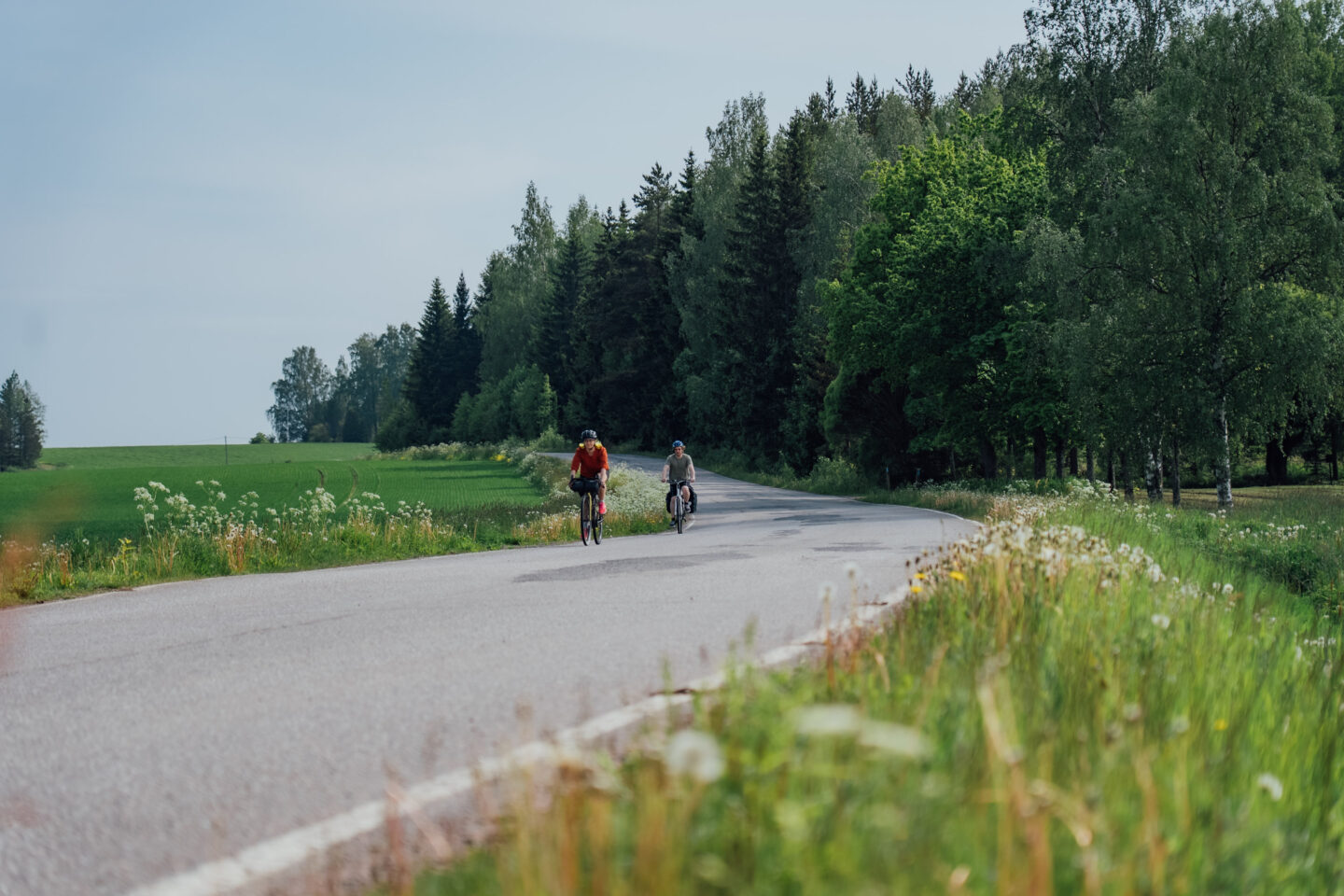
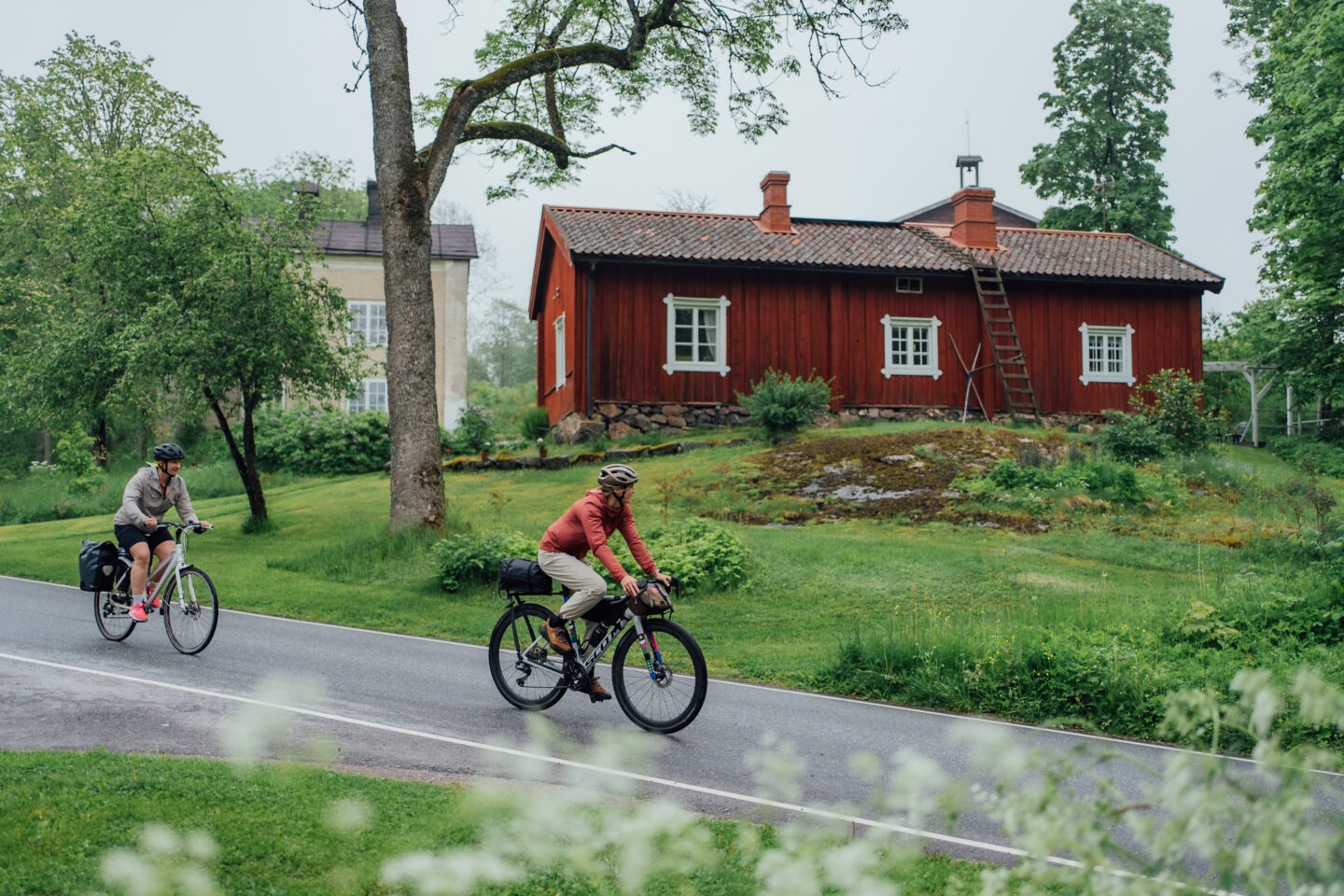
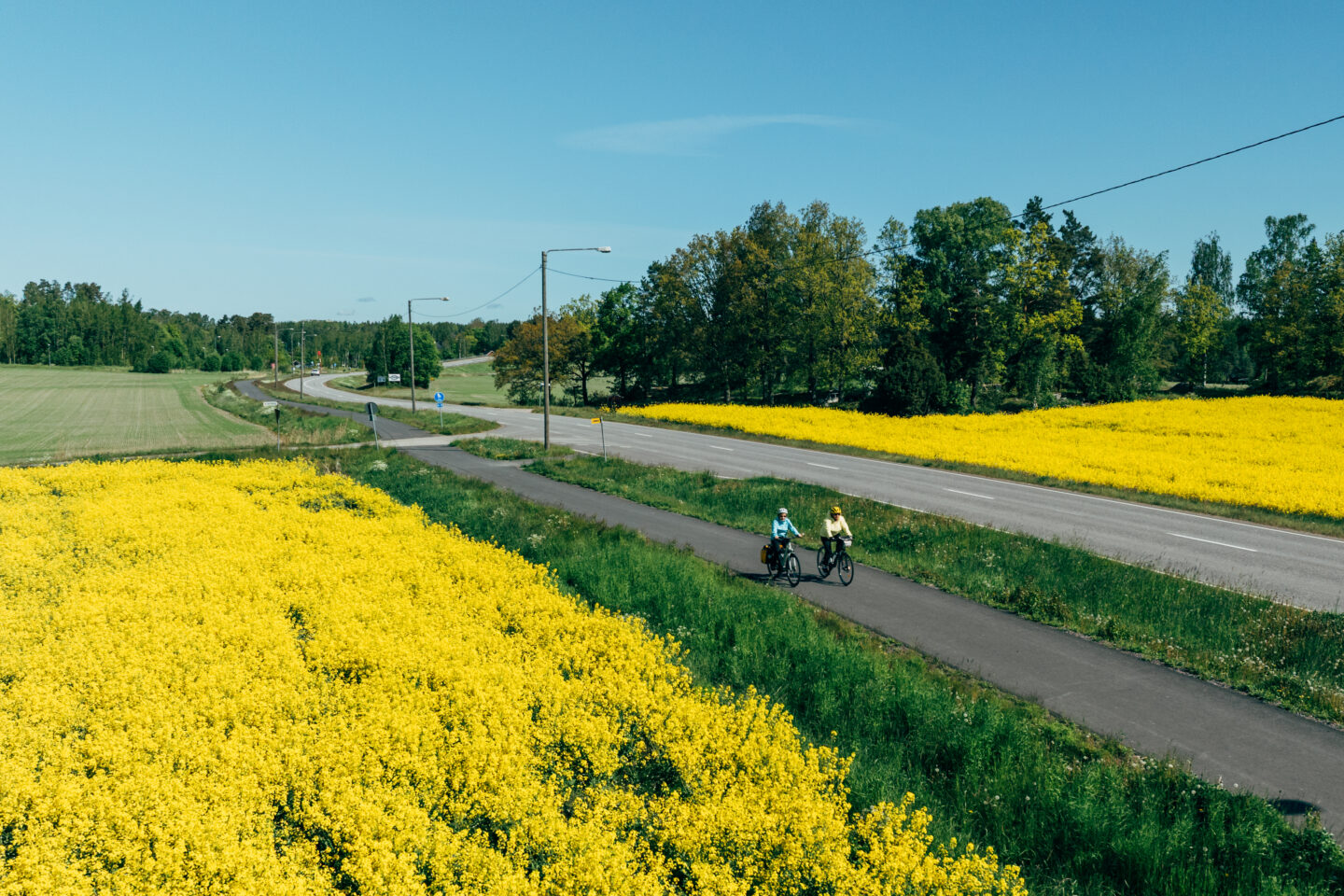
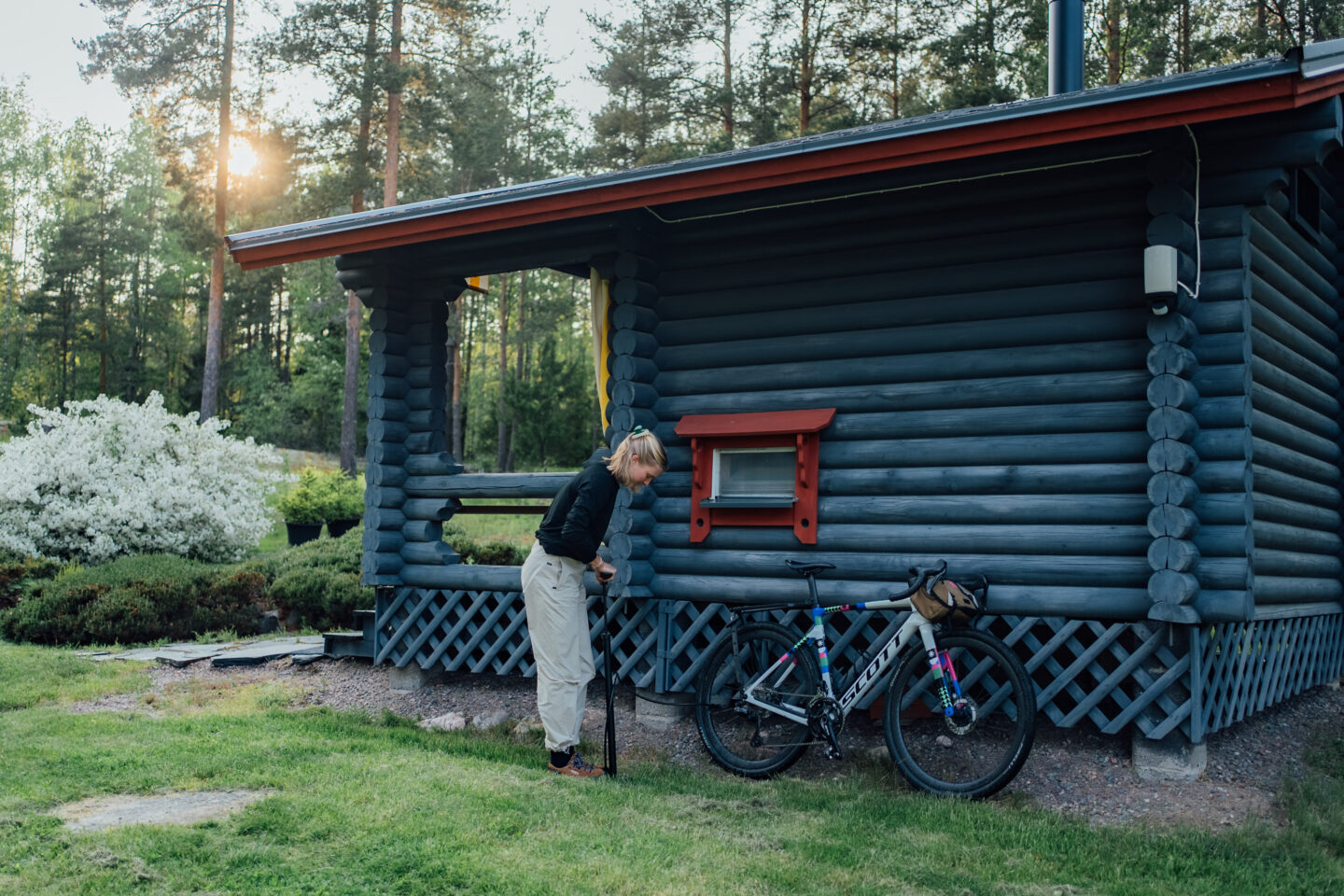
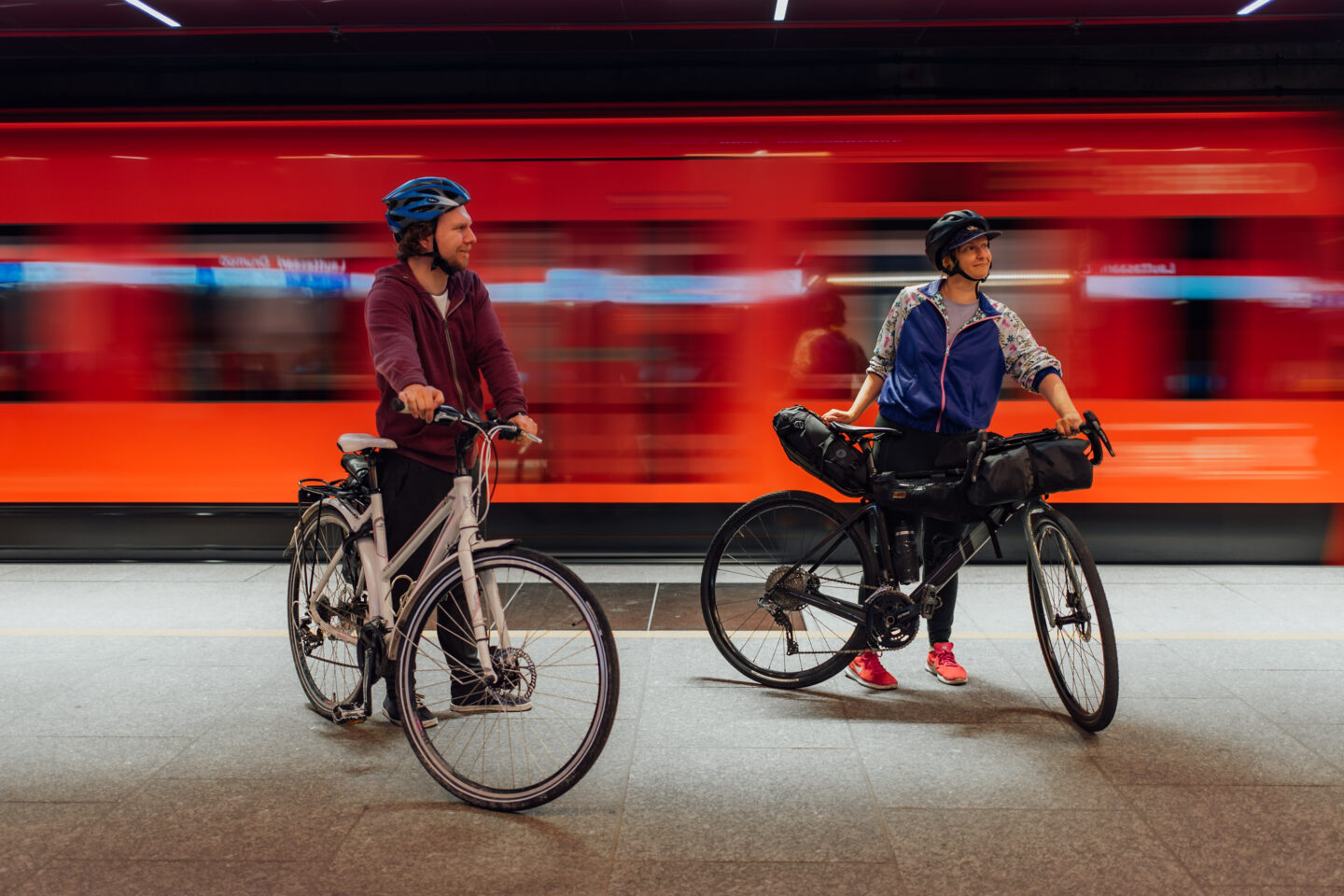
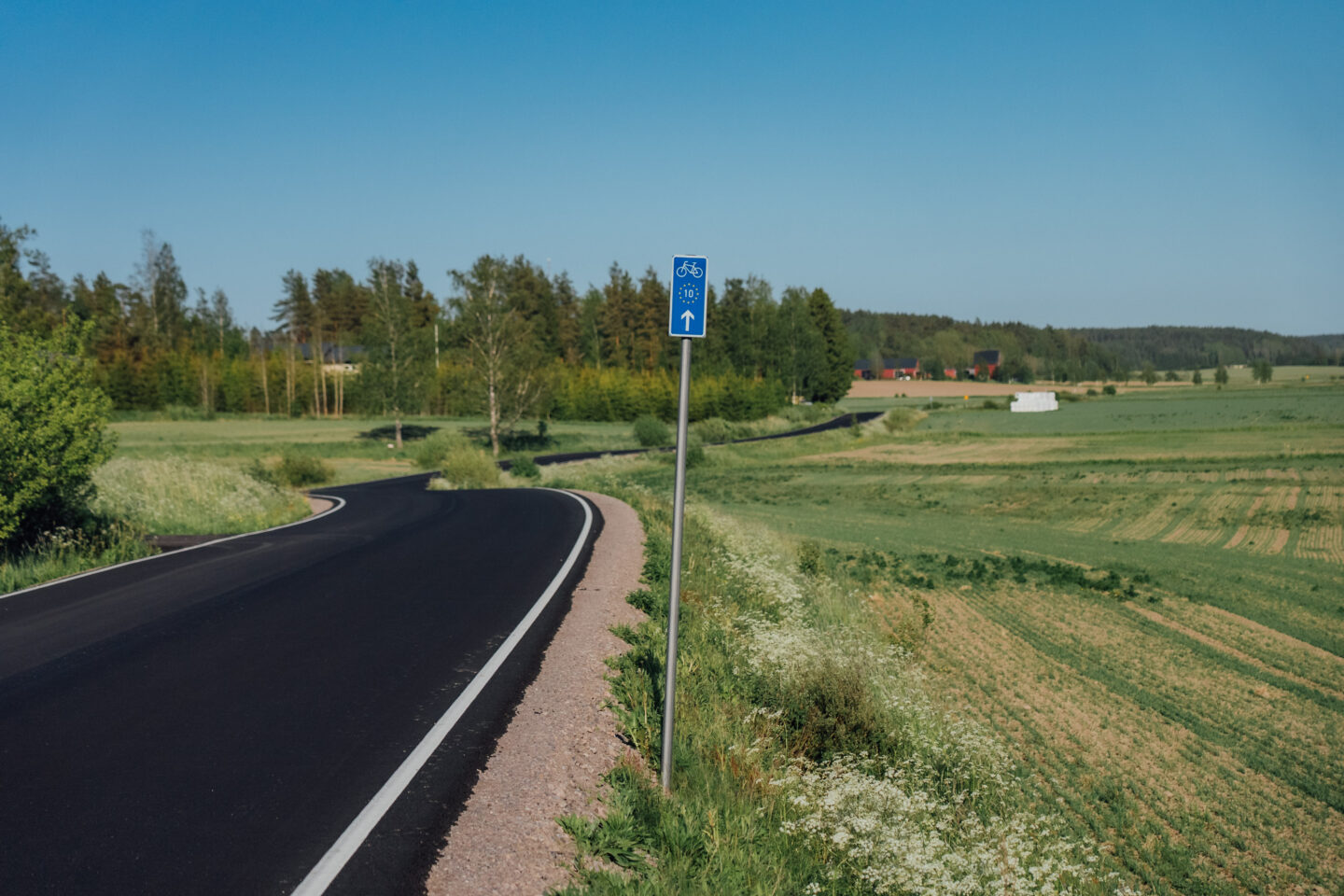
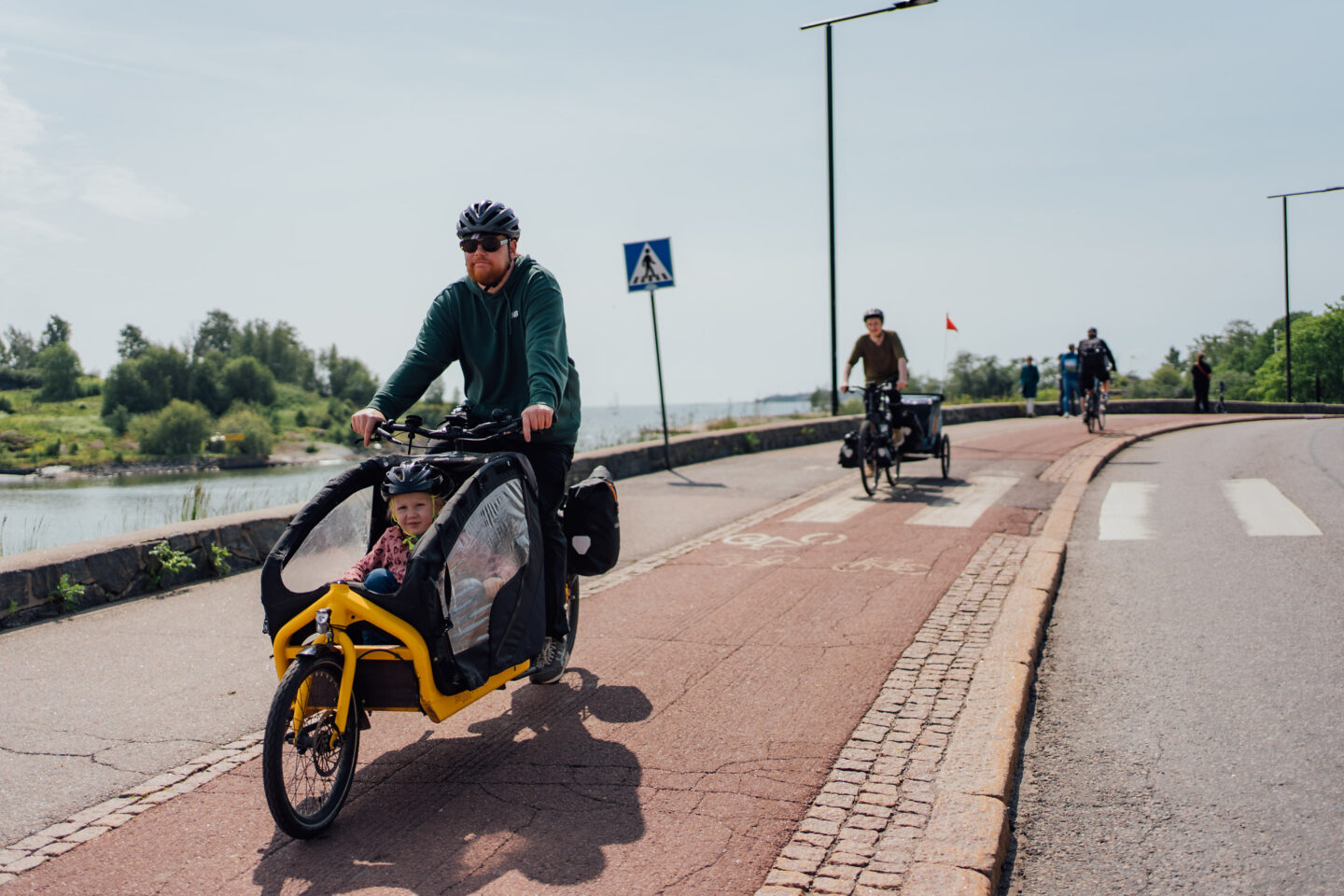
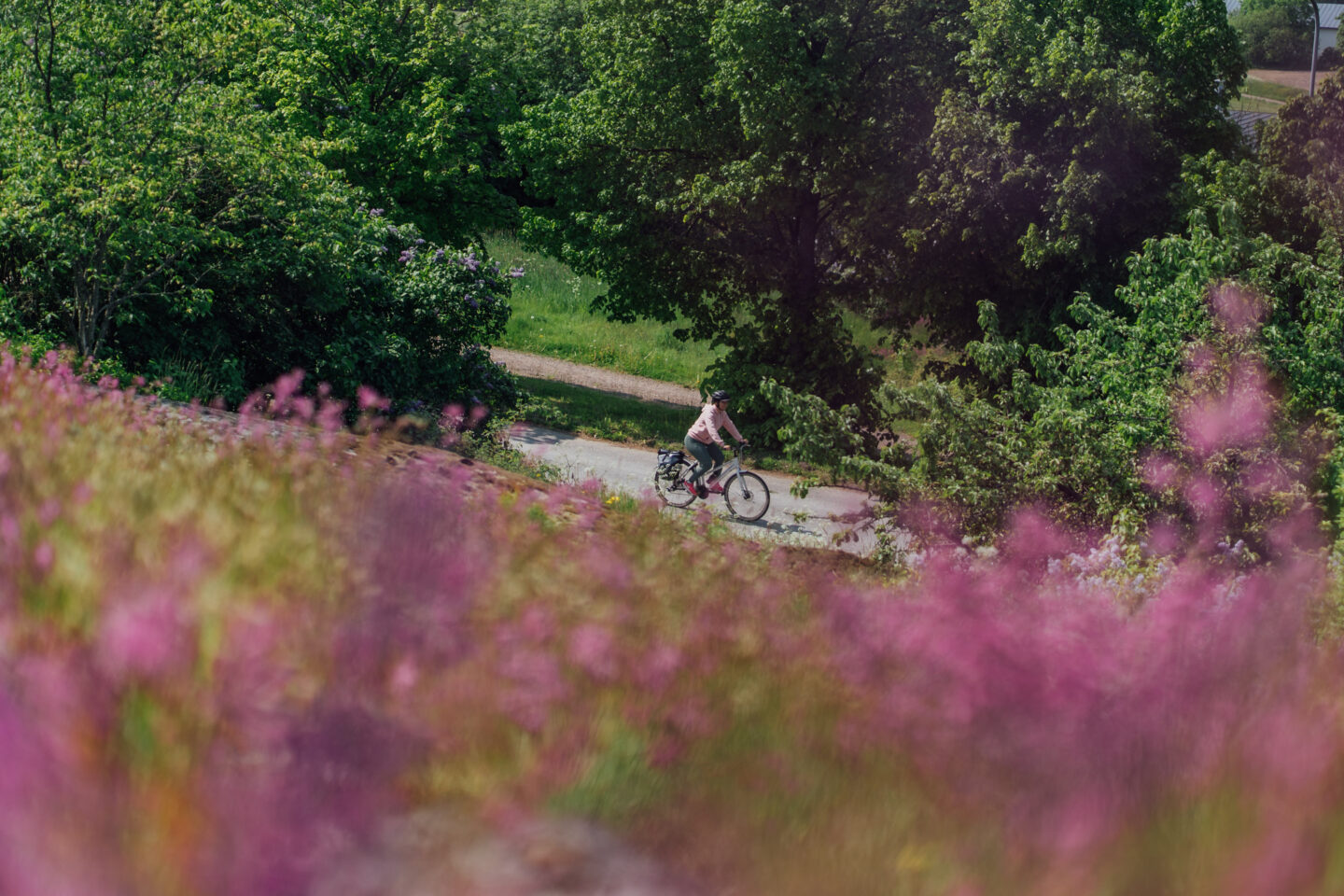
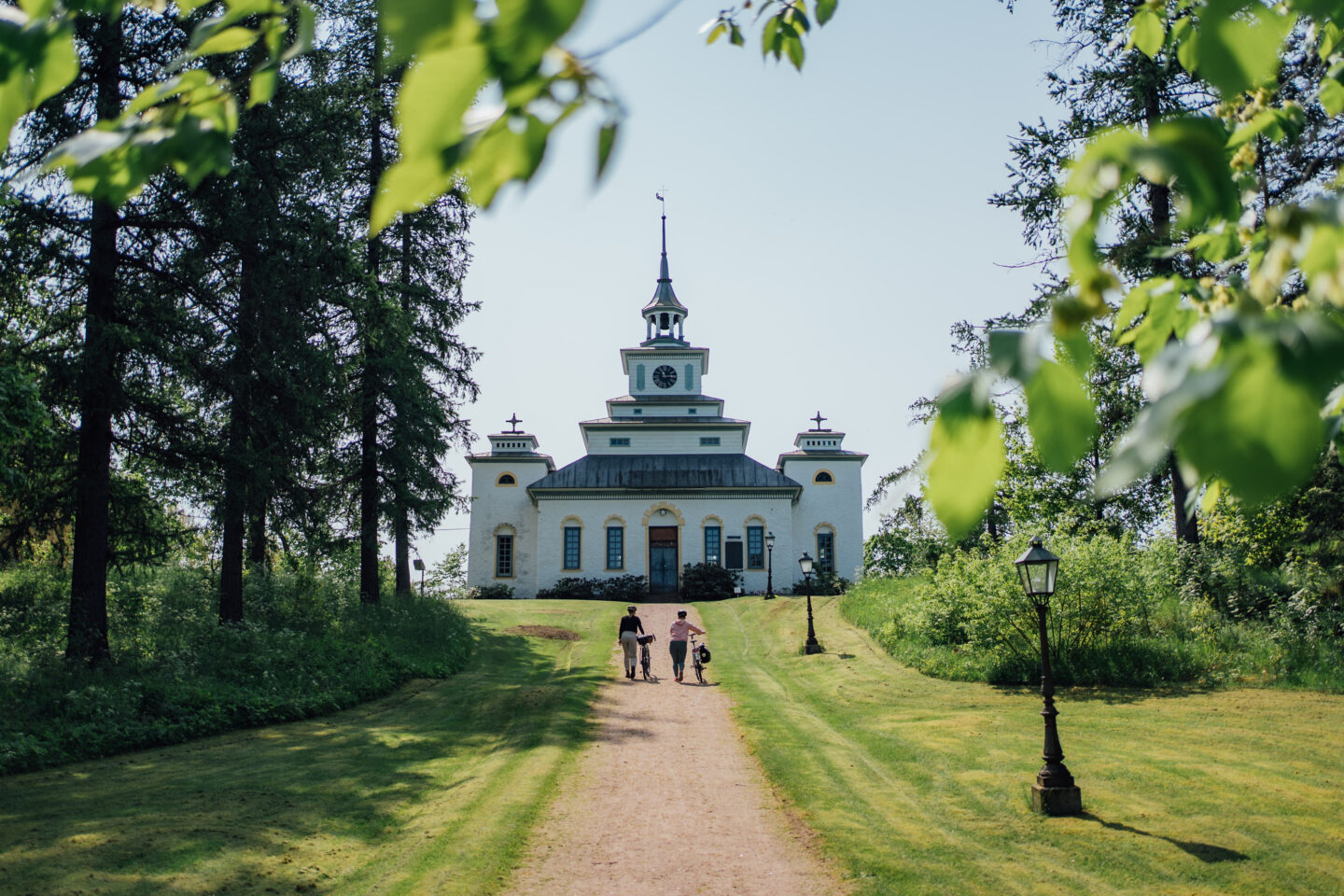
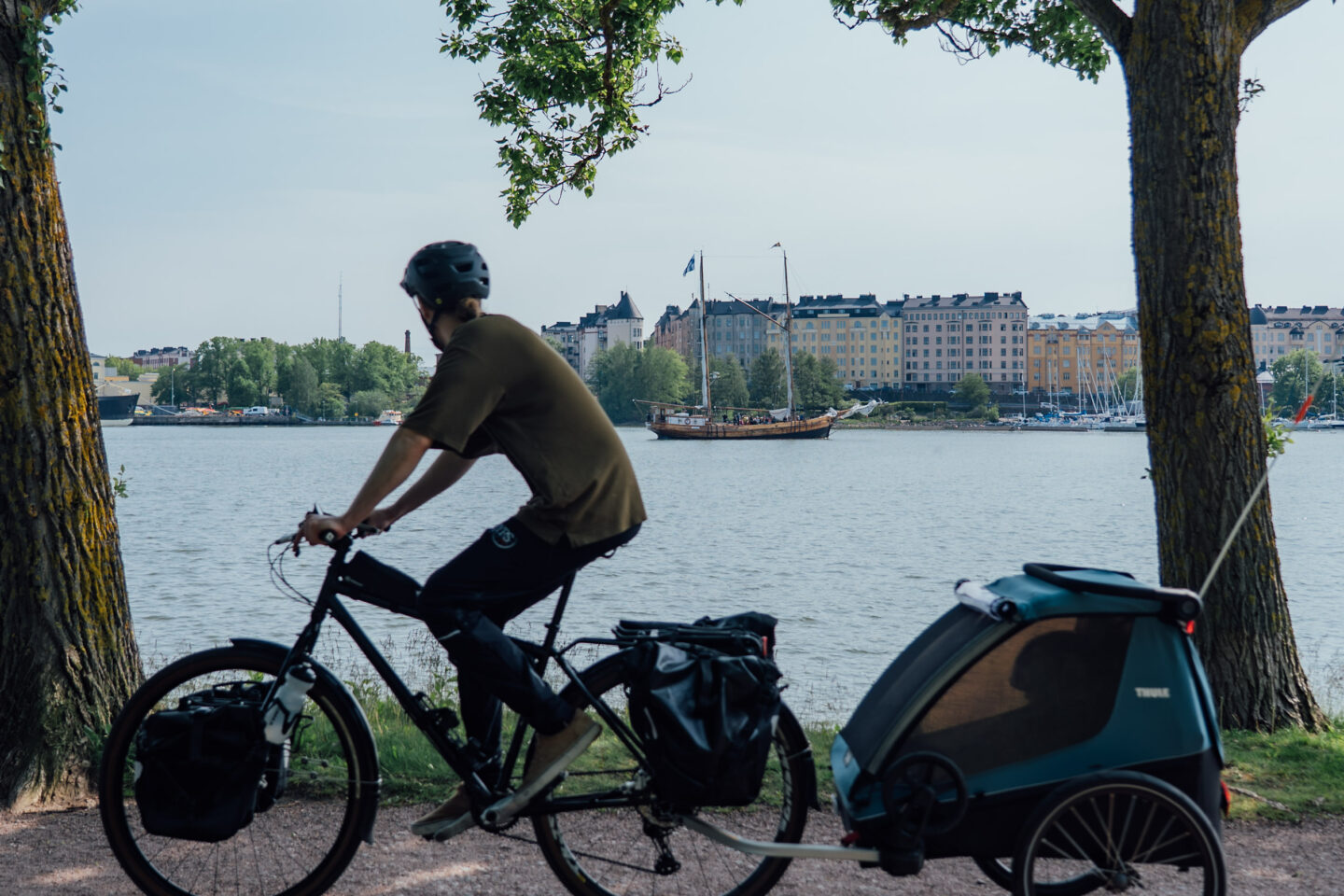
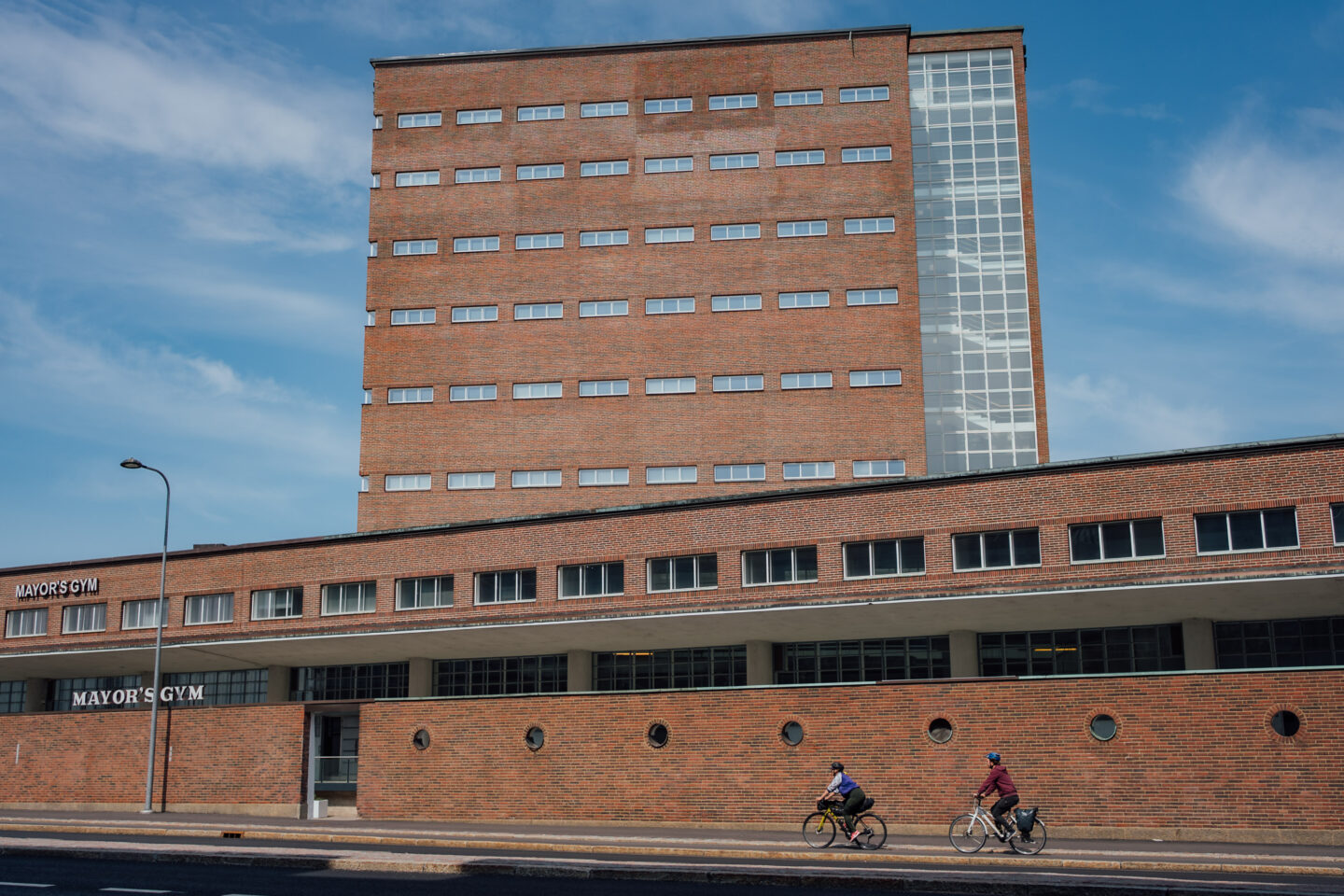
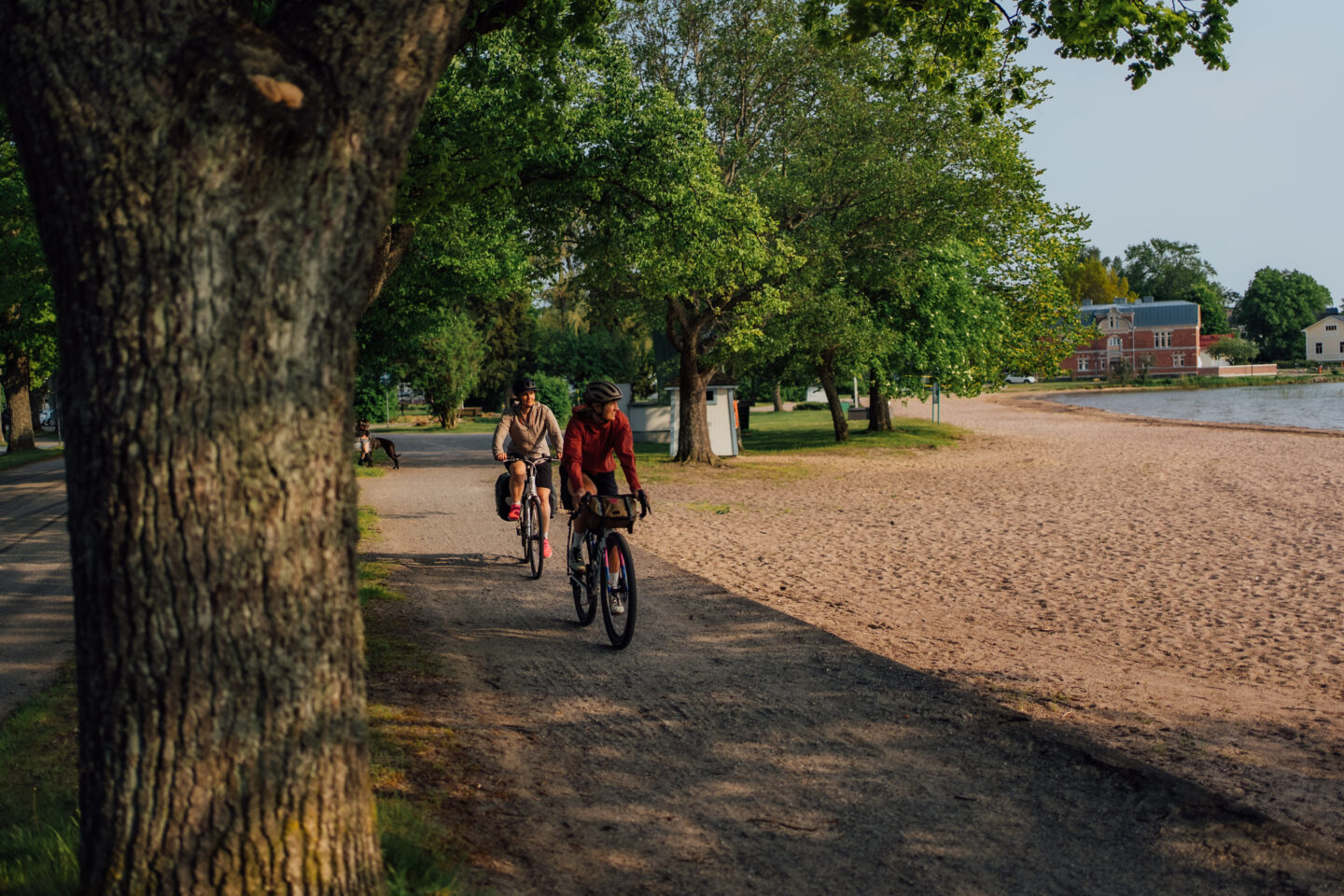
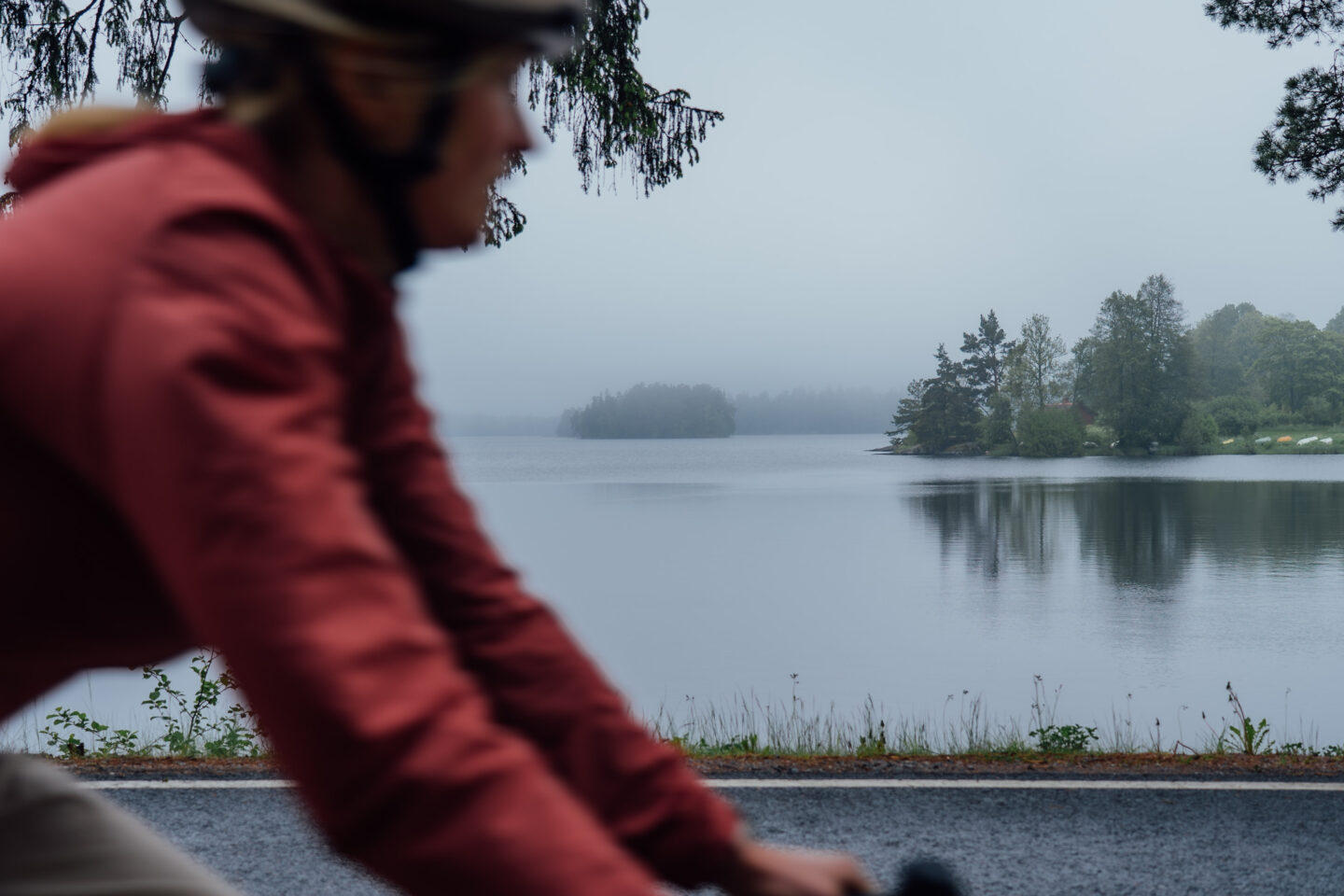

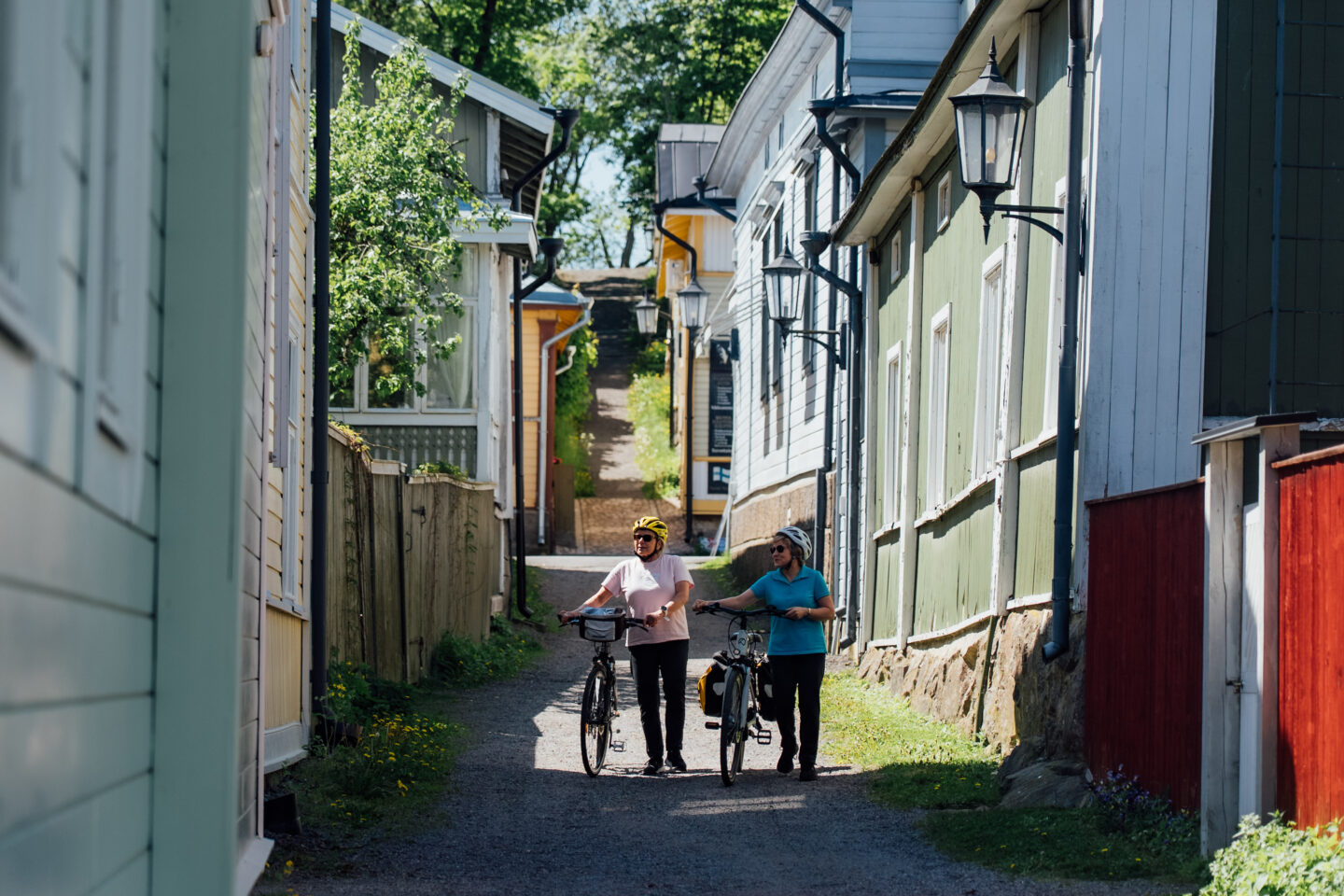
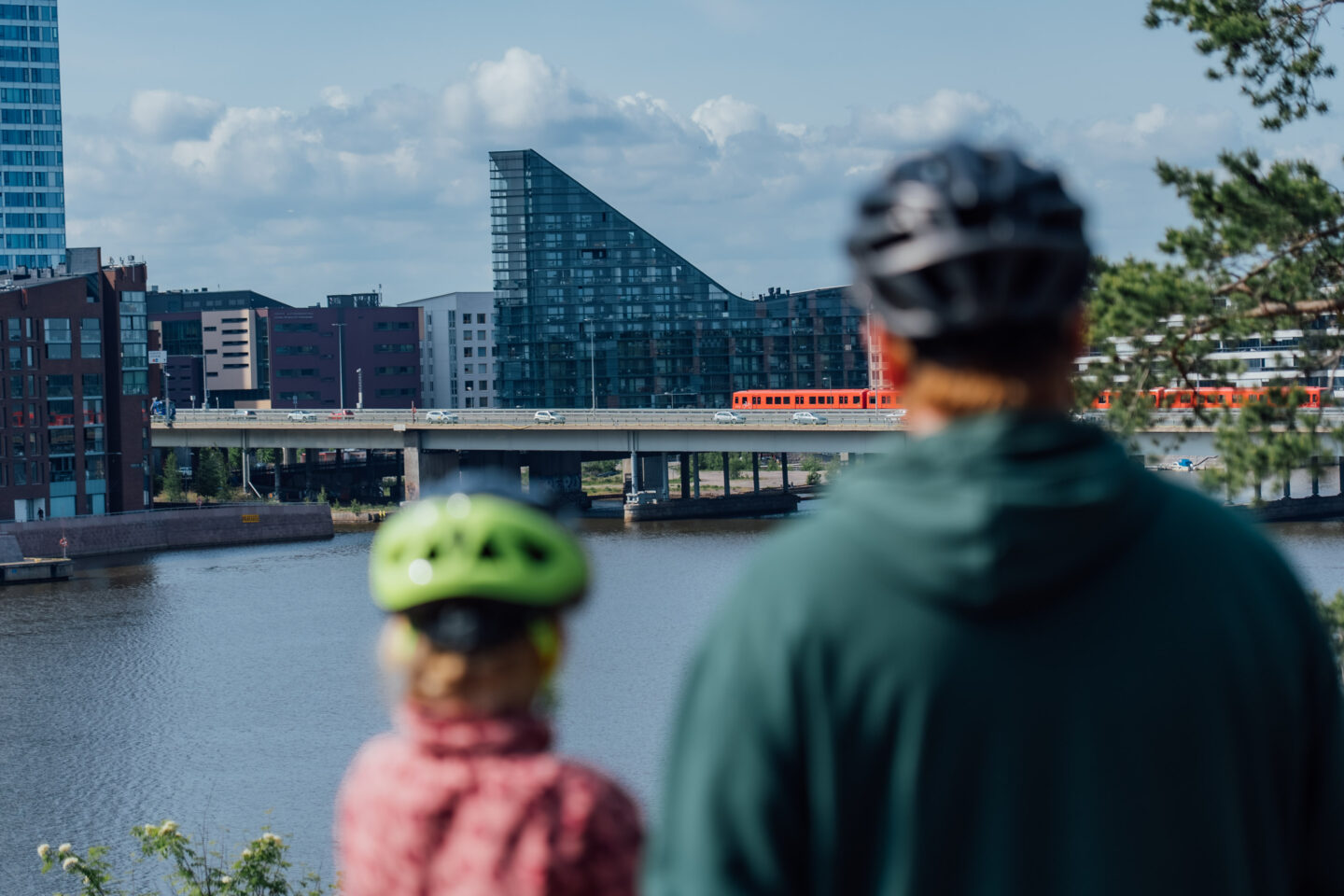
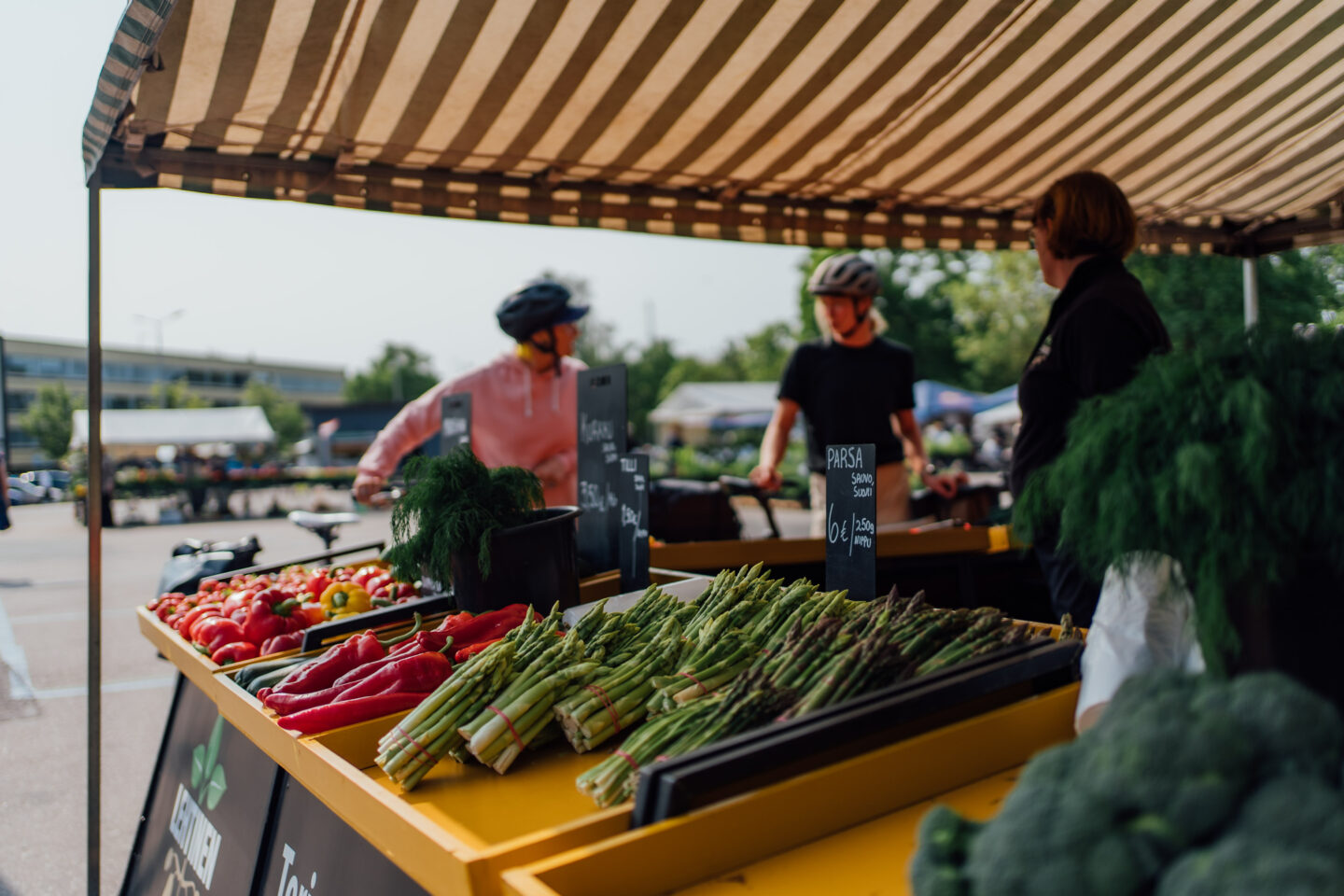
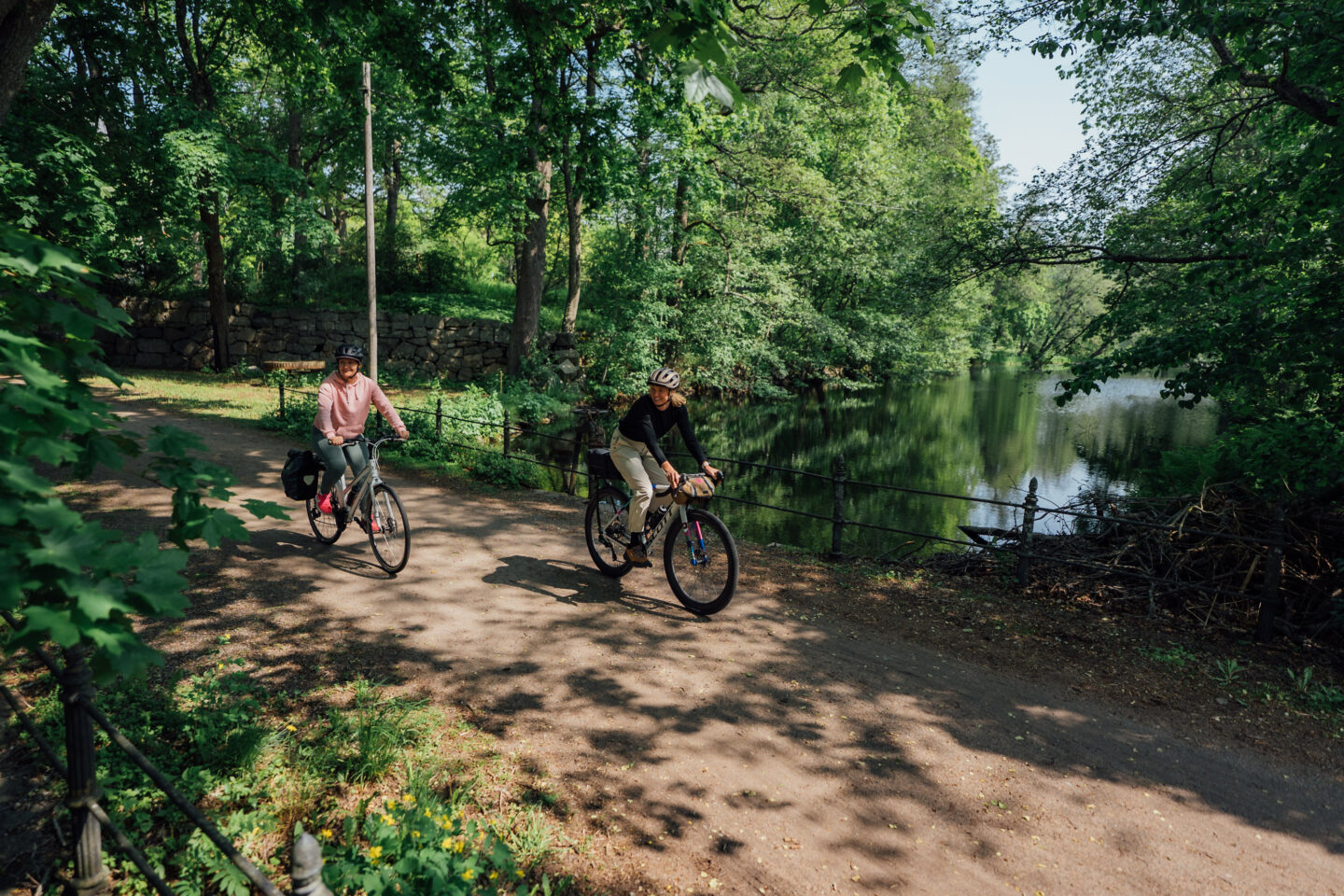
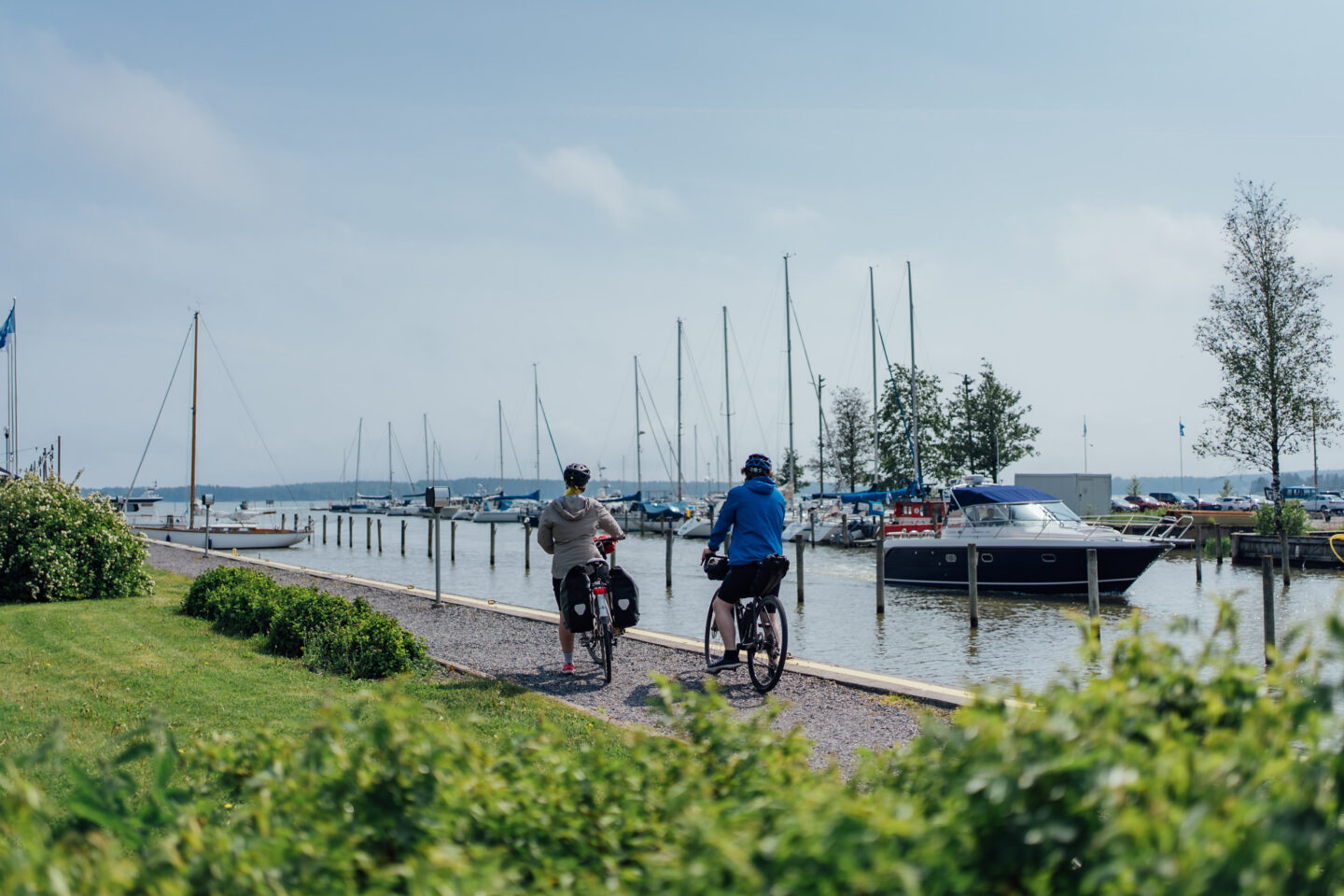
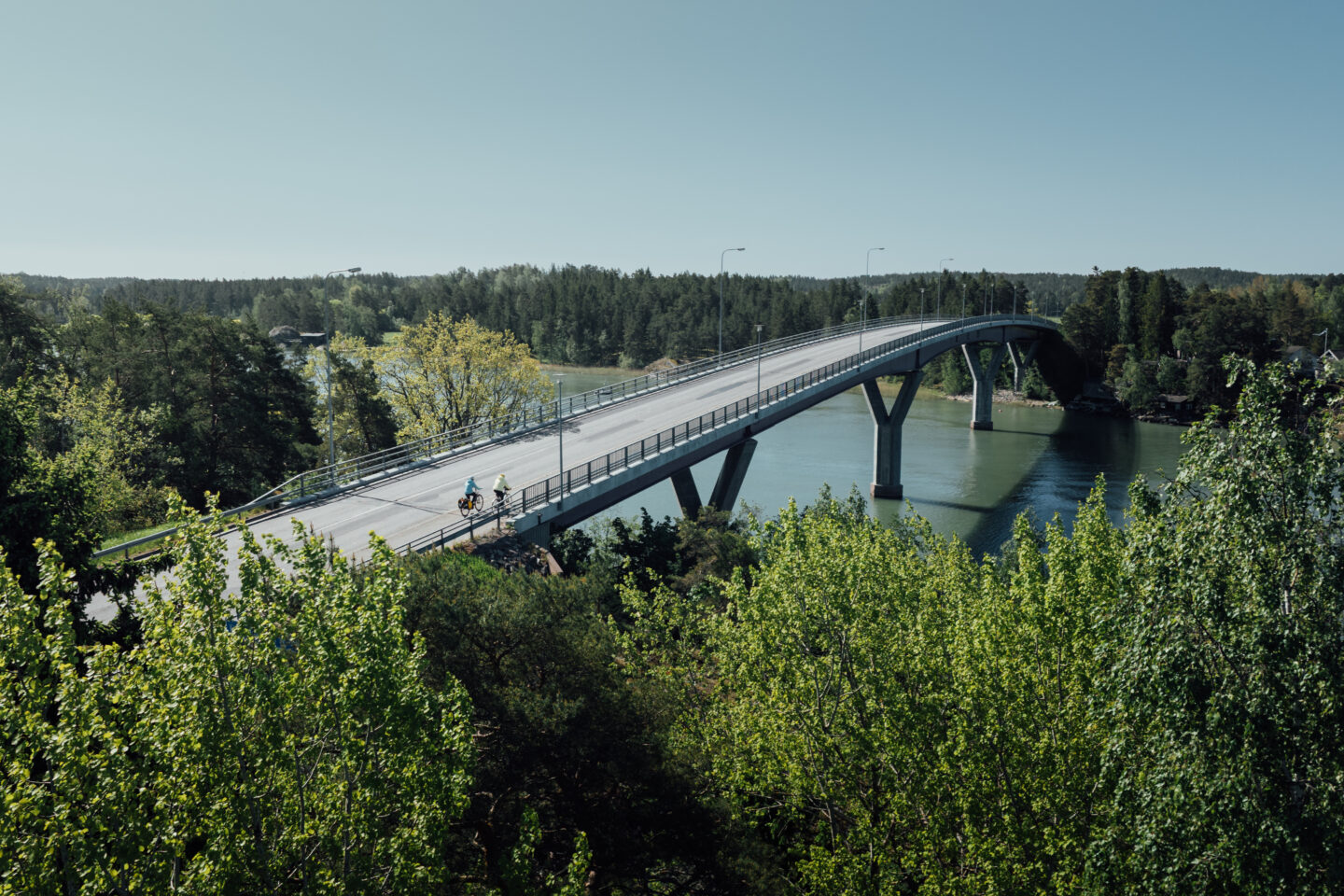
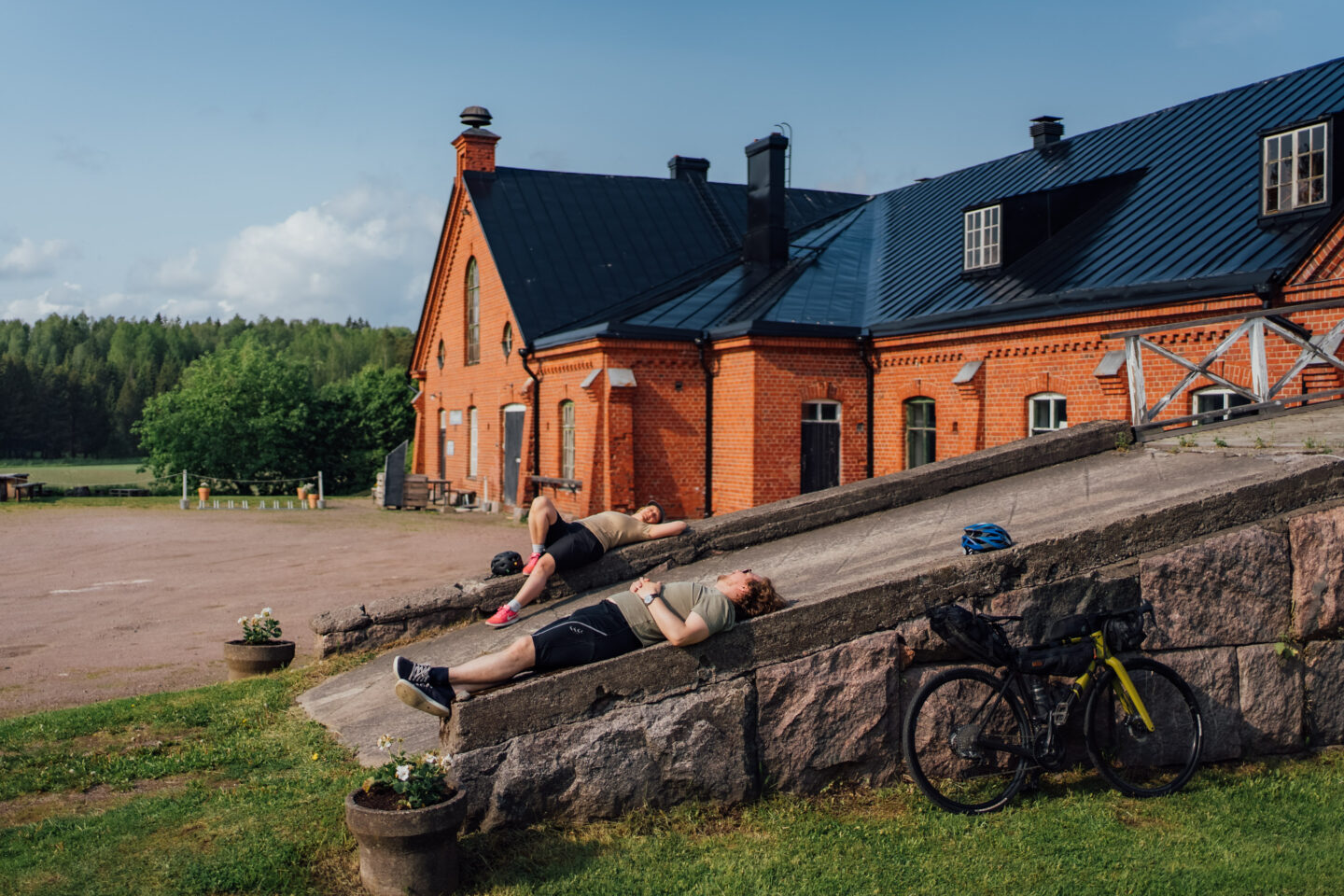
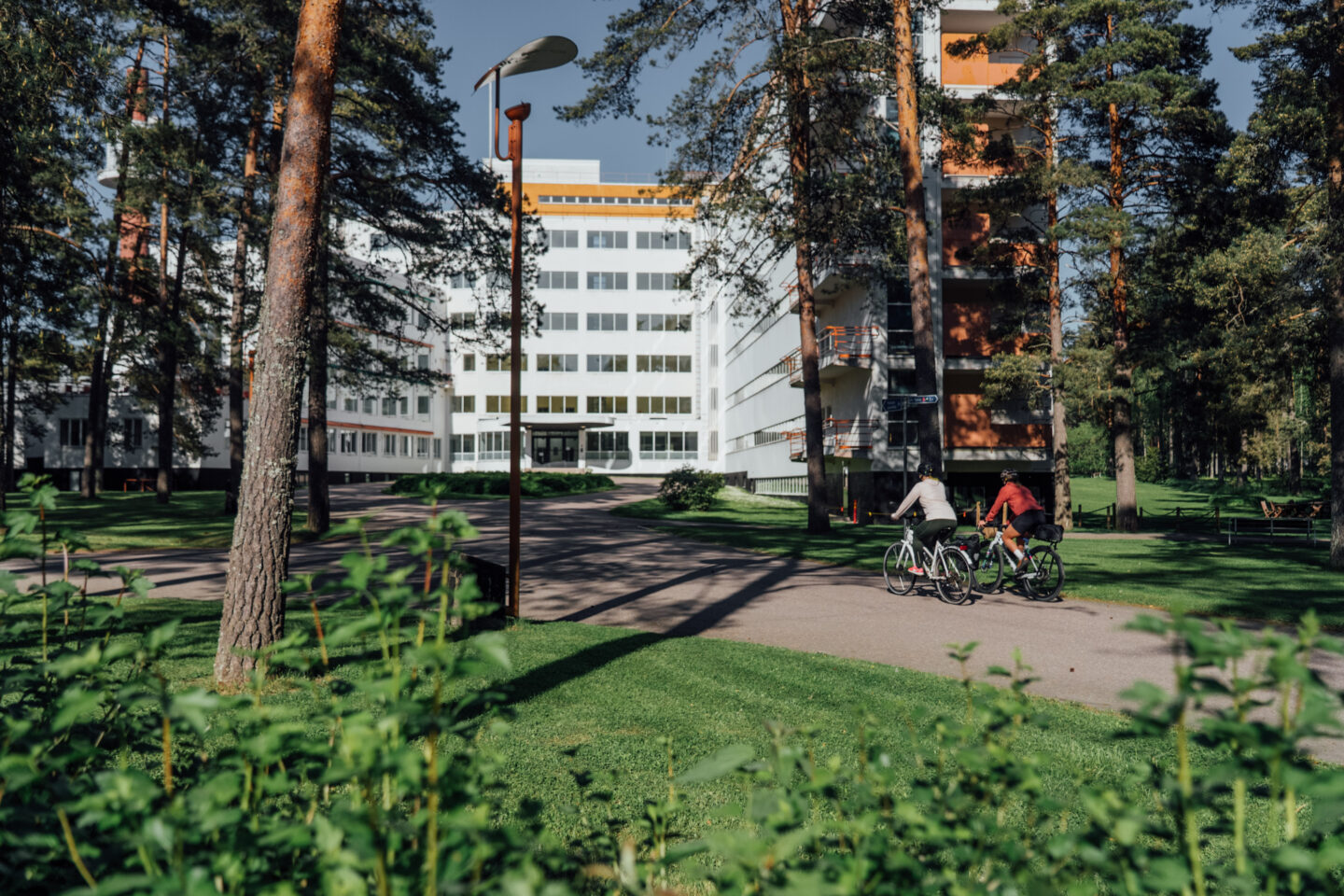
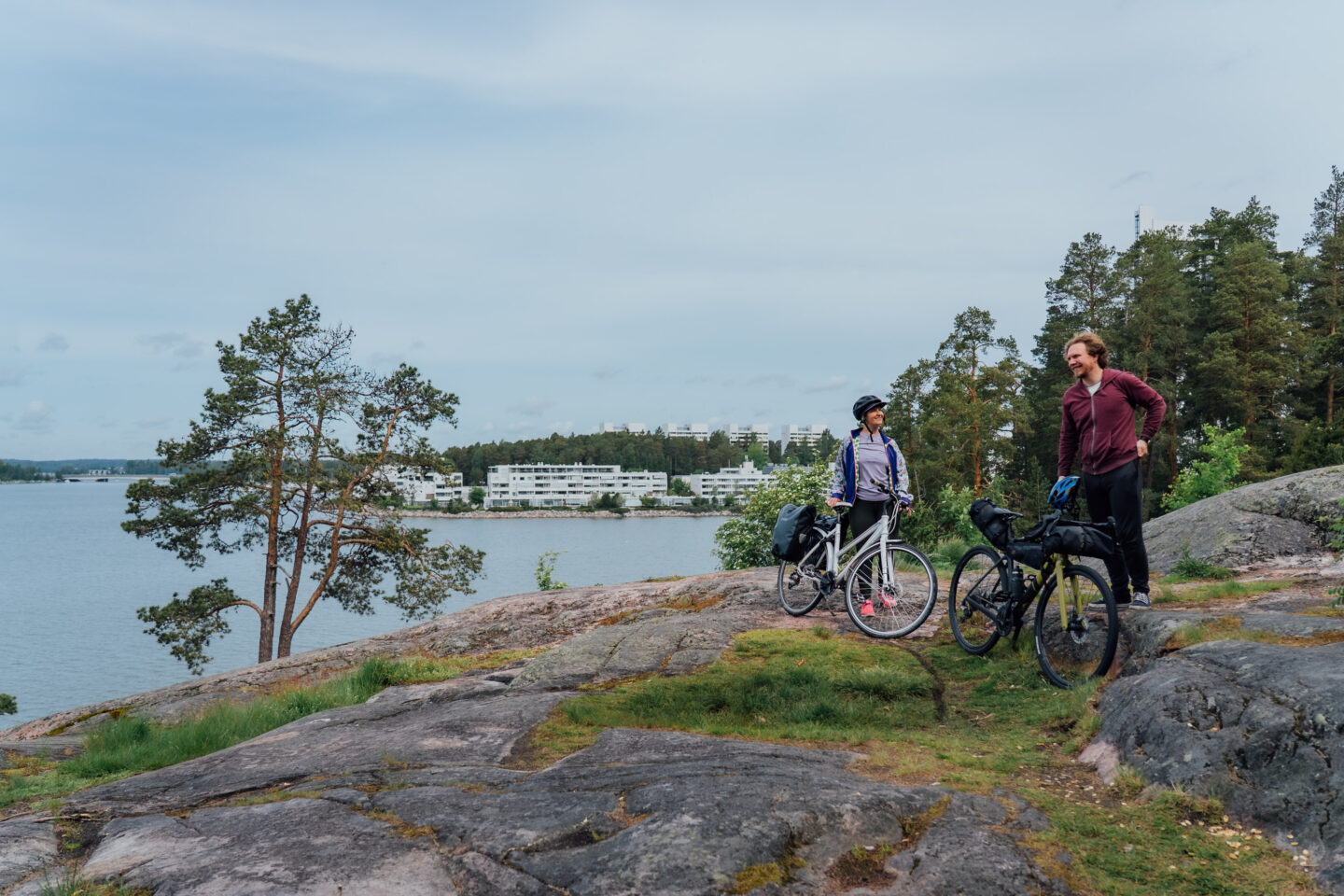
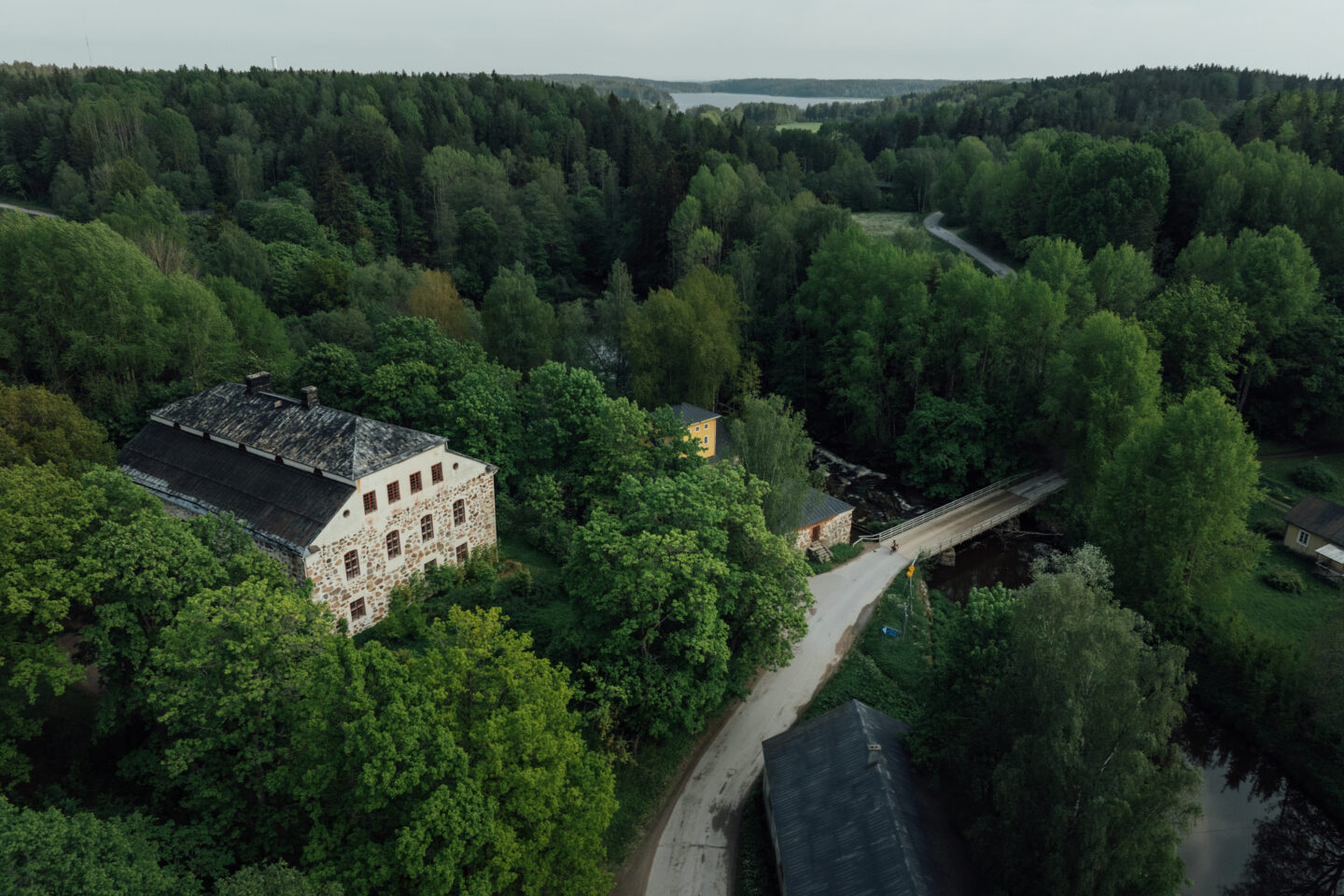
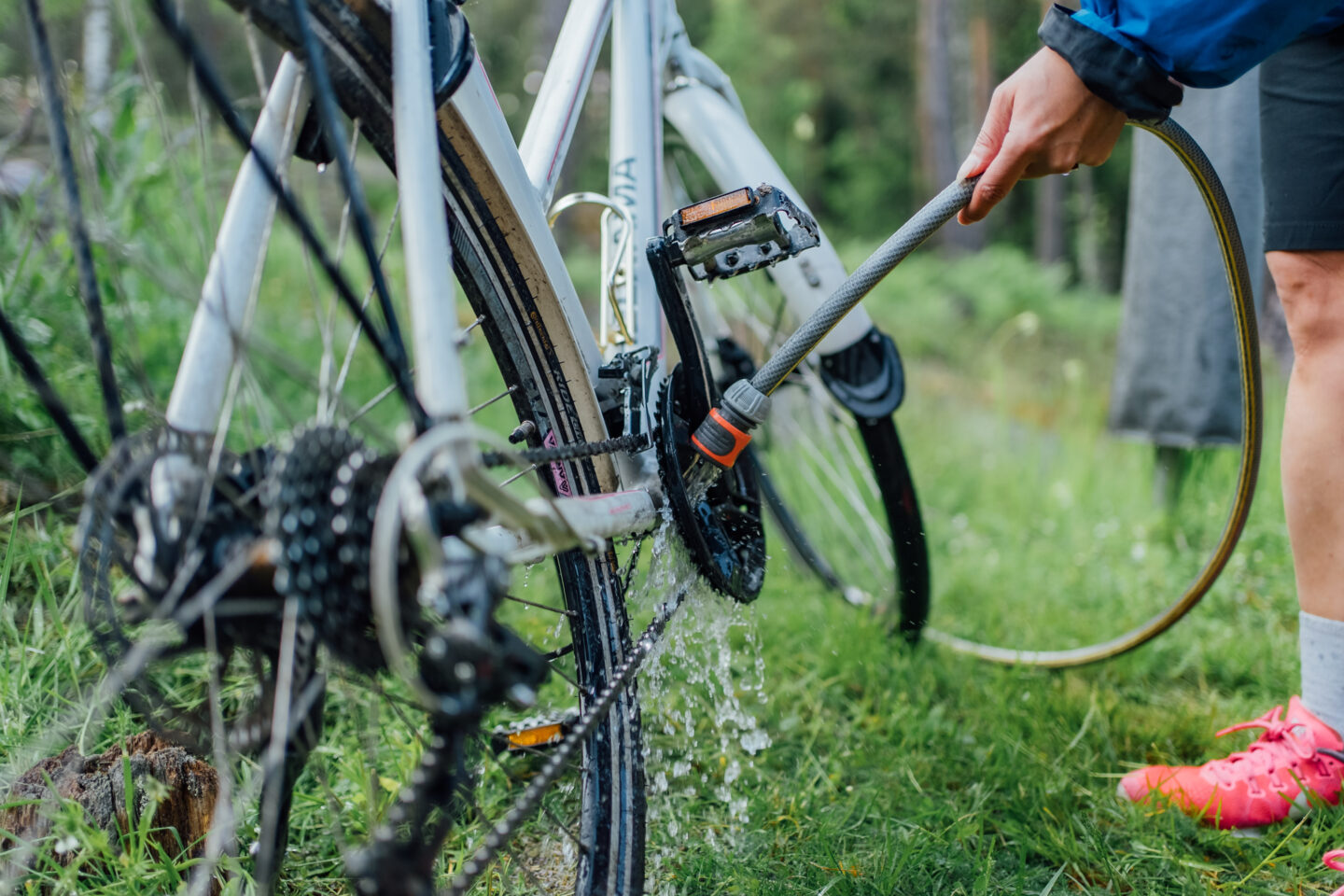
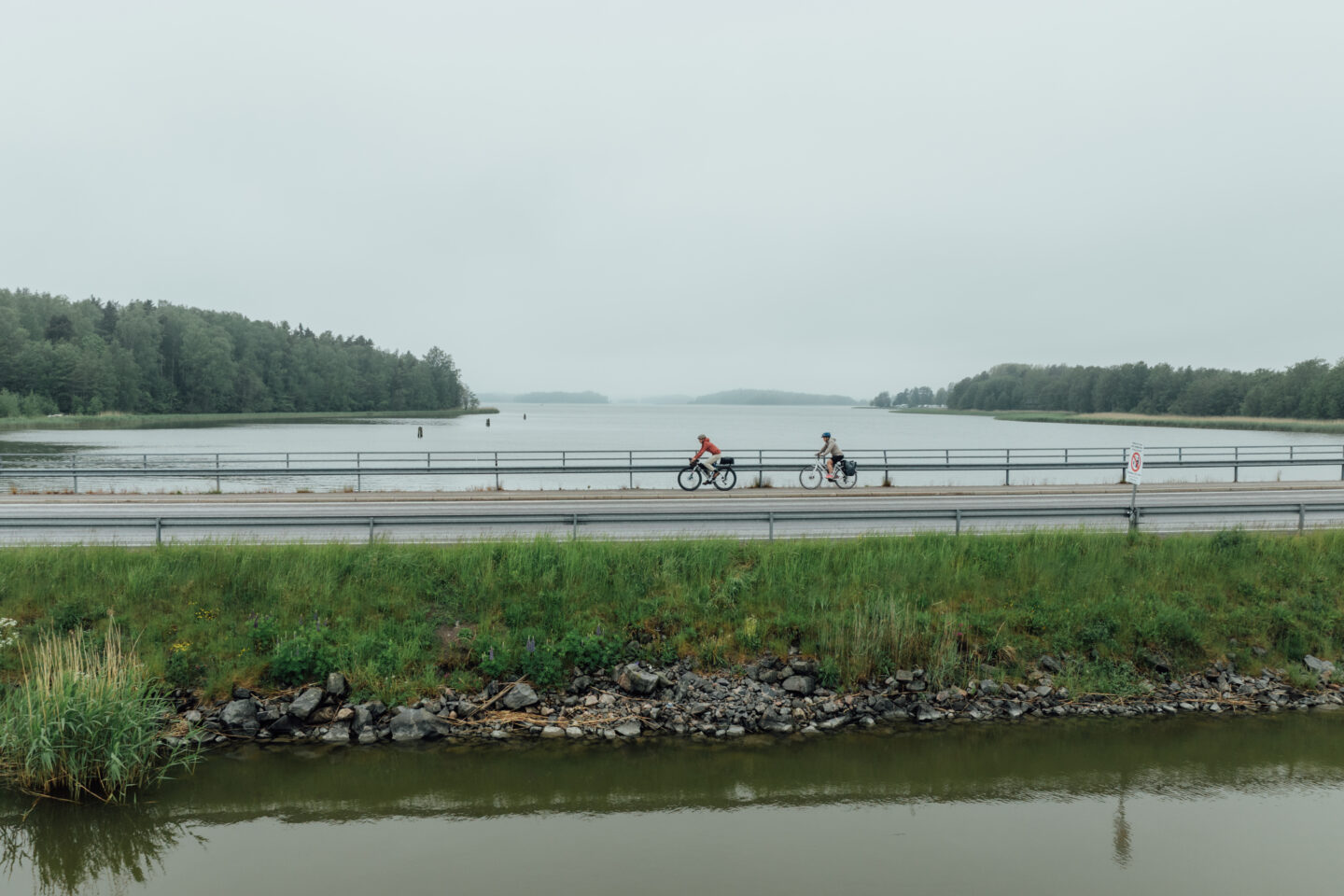
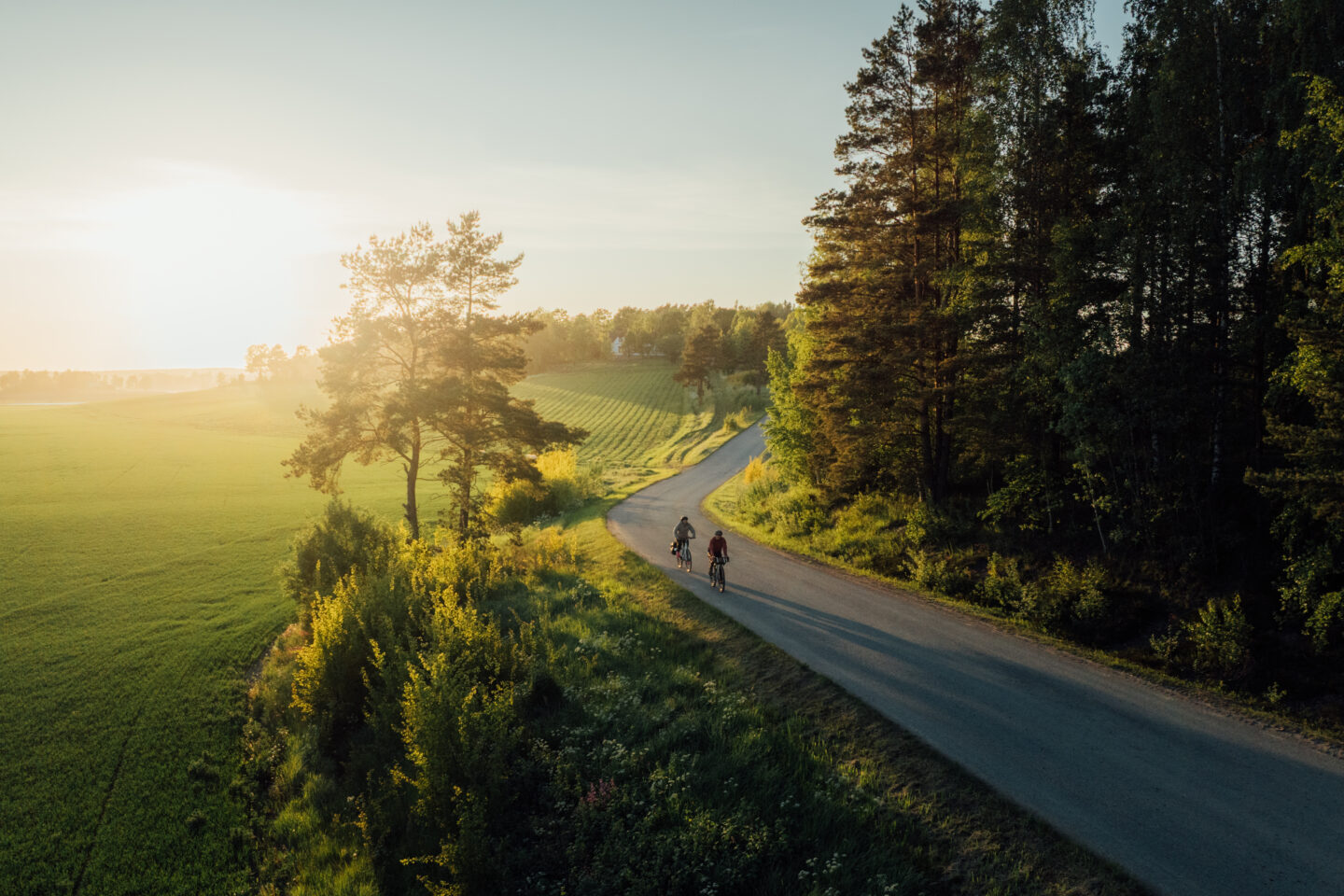
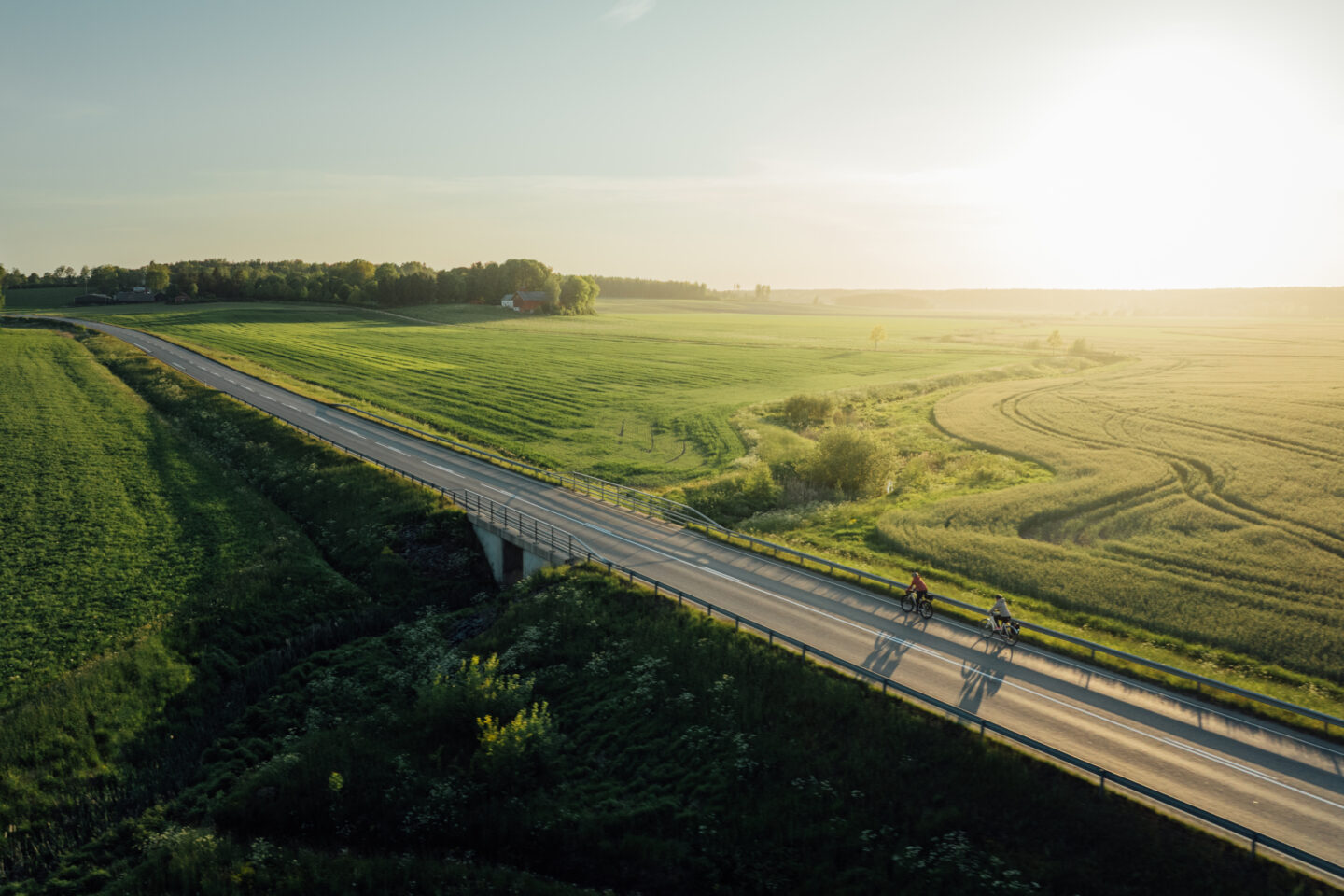
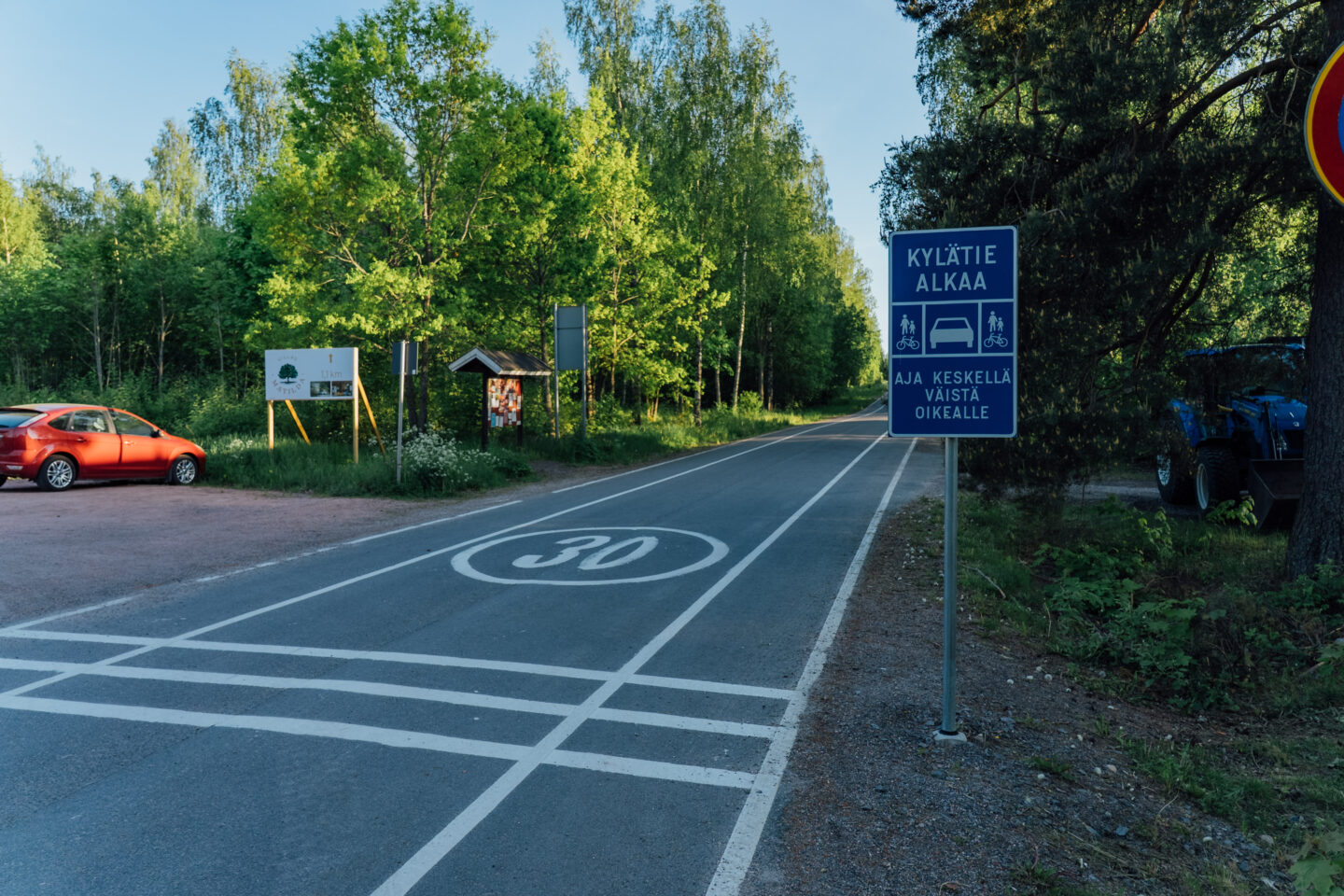
- Experience Finland’s rich sauna culture — especially in Helsinki, where you’ll find a variety of public saunas like Löyly, Allas Sea Pool, Kulttuurisauna, Uusi Sauna, and the free, volunteer-run Sompasauna.
- Berry picking is popular from late July through September, with forests full of raspberries, blueberries and lingonberries.
- Paimio Sanatorium – A landmark of Finnish modernism and a key work by Alvar and Aino Aalto.
- Long summer days – from the beginning of May to the end of August, there's a minimum of 15 hours of daylight.
- Teijo National Park – A tranquil haven showcasing the diversity of Finland’s nature, where coastal waters, quiet lakes, dense forests, and marshlands meet. Well-marked trails lead through varied terrain, and visitors can enjoy activities like hiking, paddling, fishing and cycling.
- Suomenlinna Sea Fortress located on an island outside of Helsinki – A UNESCO World Heritage Site shaped by Swedish, Russian, and Finnish eras of defense.
- Old Town of Ekenäs – The first post-medieval city in Finland, full of coastal charm and history.
- Turku Archipelago – A cyclist’s paradise of 20,000 islands, offering stunning coastal views, peaceful nature, and charming villages.
- Ironworks Villages – Explore the historic charm of Mathildedal and Fagervik, along with the manorial heritage of Halikko.
- The trail is suitable for any touring bike with tires at least 32 mm wide. Experienced riders may manage with narrower ones.
- The best time to cycle in Southern Finland is May–October.
- Services are mainly open mid-May to mid-August — always check opening hours in advance.
- Warmest weather is from June to late August, with average daytime temperatures around 20°C and nights above 10°C.
- Summer days are long, and around midsummer there is no real darkness. If you're not used to the light, a sleep mask can help.
- Water and snacks are essential — services are mostly in towns and cities every 27–55 km.
- Most of the route is signposted, but we recommend downloading the GPX track and using digital navigation tools. You’ll find tips in the Bikeland blog.
- Mobile coverage is good along the entire route. In emergencies, call 112 or use the 112 app.
- There are no dedicated e-bike charging stations, but many accommodations and cafés may allow charging with your own charger — just ask.
- EuroVelo 10 continues to Sweden and Estonia, find more information about the route in Sweden eurovelo.se/eurovelo-10/ and in Estonia from visitestonia.com/en/eurovelo-cycling-routes-10-13
- There’s a good number of guesthouses, hotels and Airbnb along the trail, but mostly located in the cities and larger towns along the route; Turku, Salo, Mathildedal, Ekenäs, Ingå, Siuntio, Kirkkonummi, Espoo and Helsinki. It is highly recommended to book in advance and confirm the availability of secure bike storage before arrival.
- By Everyone’s Rights, camping is permitted and free of charge but comes with some responsibilities. You can camp for a night anywhere in nature when you keep at least a 150 meter distance to buildings or people's yards and agricultural lands and you do not cause any harm to people nor the land. More information here.
- If the wildfire warning is in effect, do not light any fires, not even in constructed campfire places. This prohibition does not apply to cooking shelters or other fireplaces with a flue. Check the situation of wildfire warnings.
- Restaurants, cafes and shops are located at regular intervals in towns along the route.
- Services are typically open from mid-May to mid-August, always check the opening times before the trip.
- You can recognise bike-friendly businesses from the Welcome Cyclist -badge
- Tap water is usually high-quality and suitable for drinking in Finland. Restaurants and shops are often happy to fill cyclists’ bottles.
- If you fill your bottle from the many creeks, rivers, and lakes along the route, you should always purify the water before using it by boiling or using filters or purification tablets.
- It is recommended that you carry with you the water & snacks you need for a day.
- Do not litter; carry out all waste and recycle at designated services.
- When wildfire warning is in effect, also campsites’ open fireplaces will have the prohibitions of making an open fire. Using a camping stove, however, is always allowed. For information about regional wildfire warnings, see ilmatieteenlaitos.fi/metsapalovaroitukset
- You can reach Turku easily by ferry from Stockholm with Viking Line and Tallink Silja.
- Also Naantali has a ferry connection from Kapellskär (Sweden) with Finnlines.
- Helsinki has great ferry connections to Travemünde (Germany) with Finnlines, Tallinn (Estonia) with Viking Line, Eckerö Line, Tallink-Silja and to Stockholm (Sweden) with Viking Line and Tallink-Silja.
- Find the locations of the ferry terminals on Bikeland EuroVelo 10 route map.
- Airports are located in both Helsinki and Turku, offering good flight connections.
- You can easily travel between Turku and Helsinki by train. Stations along the EuroVelo 10 route include Turku, Salo, Siuntio, Kirkkonummi, and Helsinki. Visit vr.fi to buy train and bike tickets.
- Buses also run between Helsinki and Turku. For schedules and tickets, check matkahuolto.fi. Some buses allow advance bike ticket purchases, while others require arranging directly with the driver.
- Tip: Short on time or want to ride only selected sections? Consider combining cycling with a train or bus ride to focus on your favorite parts of the route.
- Find information about the EuroVelo 10 in Sweden from eurovelo.se/eurovelo-10/
- Find information about the EuroVelo 10 in Estonia from visitestonia.com/en/eurovelo-cycling-routes-10-13
📏 Distance: 32 km ⬆️ Elevation gain: 170 m
🛣️ Surface: Mostly paved, short gravel sections
🏙️ Main towns/villages: Turku, Kaarina, Paimio
🍴 Services: Frequent in Turku and Kaarina, limited in Paimio
🛏️ Accommodation: Paimio Sanatorium, Kuninkaantie guesthouse
🎯 Highlights: Turku Cathedral, Aura riverside cafés, Aalto's Paimio Sanatorium
⚠️ Note: After Turku, services are sparse—carry snacks and water
Your journey on EuroVelo 10 begins from Turku Cathedral, a landmark whose history stretches back over 700 years. In Turku, Finland’s oldest city and former capital, you can enjoy the charm of the old town combined with the vibrant cultural scene of a modern metropolis. Often called the "Paris of Finland," Turku’s bustling riverside restaurants and cafés along the Aura River are perfect places to explore by bike or on foot.
Turku offers everything a major city can provide, making it a perfect place to spend a night exploring highlights like the historic Turku Castle. Several grocery stores, kiosks, and cafés can be found along the route.
Turku is easily accessible by ferry and plane from abroad, with regular ferry services to Sweden that welcome bicycles—ideal if you wish to connect your trip to the Swedish section of EuroVelo 10. Trains and buses link Turku to other parts of Finland, and bikes are generally accepted on public transport. Buses operated by Föli run regularly to Paimio, with bicycles permitted outside rush hours (7–9 am, 4–5 pm).
Leaving Turku, you’ll follow bike paths and shared pedestrian lanes, marked with EuroVelo 10 signs, through the suburbs and the neighboring city of Kaarina. Gradually, the urban surroundings give way to peaceful agricultural landscapes. Along the way, you’ll cross a short 100-meter gravel section past a picturesque farmhouse—a reminder that rural Finland is never far away.
As you approach Paimio, the route leaves the bike path and winds through forested areas and open fields. Crossing the Paimionjoki River, you’ll spot the old railway bridge before reaching the small city center.
In Paimio, accommodation options are limited but unique: stay at the famous Paimio Sanatorium, a modernist masterpiece designed by Alvar Aalto (guided tours available in summer: paimiosanatorium.com), or go for the charming Kuninkaantien kestikartano, an old manor house turned affordable lodging. Those interested in industrial history can also visit the Paimio Electricity Museum, open Tuesday to Sunday during the summer season (visitpaimio.fi).
Cyclists seeking more adventure around Turku can include the famous Archipelago Ring Road, accessible from Turku and Kaarina. Learn more: visitparainen.fi/en/archipelago-trail.
Day 2: Paimio – Salo
📏 Distance: 38 km ⬆️ Elevation gain: 230 m
🛣️ Surface: 100% paved country roads
🏙️ Main towns/villages: Paimio, Halikko, Salo
🍴 Services: Small rest stop in Trömperi, full services in Halikko and Salo
🛏️ Accommodation: Hotels and guesthouses in Salo
🎯 Highlights: Rural farmland, Halikko heritage, Electronics Museum in Salo
⚠️ Note: Limited public transport connections mid-route
Today’s ride from Paimio to Salo takes you through typical southern Finnish agricultural landscapes. The journey follows quiet, paved country roads where you’ll mostly cycle on the shoulder. While the route is peaceful, cycling infrastructure is limited outside urban areas.
After about 12 km, you’ll find Trömperin kestikievari, an inviting old wooden inn offering a glimpse into the rural life of the past—an ideal spot for a break. Services become more abundant after another 13 km, in Halikko, a suburban area just outside Salo, where you'll find grocery stores and restaurants.
Salo offers all the services you might need, from hotels to museums. Particularly worth visiting are the Electronics Museum and the "Made in Salo" exhibition, which showcase the city's legacy in telecommunications and television manufacturing (salomus.fi). In the summer, the famous Thursday evening market fills the main square with fresh products, music, and a lively atmosphere.
Public transport connections improve near Salo. Paimio remains connected to Turku via Föli buses, while Salo has excellent bus and train links toward Helsinki and Turku. However, note that public transport is limited along the rural sections between Paimio and Salo.
Day 3: Salo – Mathildedal
📏 Distance: 26 km ⬆️ Elevation gain: 260 m
🛣️ Surface: Paved and gravel mix (short detour to Kirjakkala = gravel)
🏙️ Main towns/villages: Salo, Teijo, Mathildedal
🍴 Services: No services before Teijo and Mathildedal
🛏️ Accommodation: Hotels and B&Bs in Mathildedal (limited in summer)
🎯 Highlights: Uskelanjoki River, Kirjakkala & Teijo ironworks, National Park
⚠️ Note: Short hills – consider low gears for comfort
Leaving Salo, you’ll follow the Uskelanjoki River southwards, staying on a shared pedestrian and cycling path for the first 4 km. After Kärkkä, you’ll transition onto the shoulder of Merikulmantie and Teijontie roads, heading toward the historic ironworks villages and Teijo National Park.
This section offers a mix of gentle agricultural landscapes and serene coniferous forests, though it is hillier than previous days—pace yourself and enjoy the scenery. For those wishing to explore more, a short 2 km detour down a gravel road leads to the beautifully preserved Kirjakkala ironworks village.
The EuroVelo 10 route also passes through the Teijo ironworks village, where lovely cafés, restaurants, and a village shop invite you to linger.
Upon reaching Mathildedal, the road narrows into a “village street” where priority is given to cyclists and pedestrians. Mathildedal itself is a beloved summer destination with activities ranging from mountain biking at Meri-Teijo Bike Park to fishing in the Archipelago. Accommodation options are available but can be limited in high season, so booking ahead is recommended.
Day 4: Mathildedal – Ekenäs (Tammisaari)
📏 Distance: 52 km ⬆️ Elevation gain: 420 m
🛣️ Surface: Paved + ~8 km gravel
🏙️ Main towns/villages: Perniö, Tenala, Ekenäs
🍴 Services: None for 27 km (except Pikantti self-service kiosk), grocery in Tenala
🛏️ Accommodation: Hotels and B&Bs in Ekenäs
🎯 Highlights: Coastal views, Tenala village, historic Ekenäs old town
⚠️ Note: Route 52 has busy traffic — use caution or follow Coastal Route (+12 km)
Departing Mathildedal along a quiet village road, you’ll quickly find yourself surrounded by pine forests and open farmland. After turning onto Kemiöntie, stock up on local treats at Pikantti, a self-service kiosk—the last chance to resupply before a 27 km stretch without services.
This day includes about 8 km of gravel roads, spread across a few sections. Most notably, you’ll encounter long, scenic gravel stretches along Laukantie, Heikkiläntie, and Hästöntie—beautiful rural roads with very little traffic.
However, caution is needed after reaching Perniöntie (Route 52), a high-traffic paved road where you’ll ride along the shoulder for about 8 km. If you prefer a quieter alternative, you can detour via the signposted Coastal Route (Rannikkoreitti), which follows smaller, partly gravel roads (ridewithgps link). The detour adds 12km to your journey but rewards you with a calmer ride.
Shortly before Tenala, the route turns off Perniöntie onto quieter local roads. In Tenala village, with its charming red houses and medieval stone church, you'll find a grocery store and a lunch restaurant—ideal for a break before the final 19 km stretch to Ekenäs (Tammisaari).
Shortly before reaching the village of Tenala, the route veers left onto quieter roads. In Tenala, a traditional village with red-painted houses and a striking medieval stone church, you'll find a grocery store and a local lunch restaurant—an ideal spot to rest and recharge before the final leg of your journey.
From Tenala, the trail rejoins the Coastal Route and follows Bromarvintie, a gently rolling road framed by forests and farmlands. The landscape gradually transitions back to pine woods as you approach the coast.
Cross Kråkholmen Bridge, where beautiful seaside views greet you before entering the coastal town of Ekenäs (Tammisaari). Services are abundant here: enjoy the idyllic wooden old town, stroll along Finland’s oldest pedestrian street Kungsgatan, visit the lively harbor, take a refreshing swim in the Baltic Sea, or relax in the peaceful Ramsholmen forest park right next to town.
Day 5: Ekenäs - Ingå
📏 Distance: 45 km ⬆️ Elevation gain: 470 m
🛣️ Surface: 90% paved, 2 gravel sections (~8 km total)
🏙️ Main towns/villages: Snappertuna, Fagervik, Ingå
🍴 Services: Café in Fagervik (summer), grocery stores in Ingå
🛏️ Accommodation: Ingå, check availability
🎯 Highlights: Fagervik Ironworks & Manor, coastal scenery, King’s Road
⚠️ Note: More rolling hills today
From Tammisaari (Ekenäs), the southern point of the EuroVelo 10 route in Finland, your journey continues eastward following the EuroVelo signs. The route is mostly paved, with two unpaved sections that together make up about 8 km of gravel roads.
The first stretch follows cycle paths for 4 km, taking you past Ekenäs’ charming wooden houses and green parks before leading you onto winding country roads. The initial 2 km of this road can be a bit busier, but once you make the turn, traffic eases, and you can relax into the peaceful sounds of nature and enjoy the scenic countryside.
After passing the small village of Snappertuna, you join the historic King’s Road, which leads to the unique ironworks area of Fagervik Manor, about 30 km into your ride—a must-stop for every cyclist. Nestled by a lake and surrounded by natural beauty and lush greenery, the manor, church, forges, park, and red cottages create a striking 18th-century setting rarely found elsewhere in Finland. It is also said that the first potatoes and tomatoes in Finland were cultivated here at the Fagervik ironworks. The charming summer café in the old vicarage is the perfect spot for a lunch or snack break.
After this refreshing pause, it's time for the final push—12 km to the town of Ingå. Along with its beautiful harbor and seaside views, Ingå invites you to explore its rich cultural heritage, including the old stone church dating back to the 1500s.
Day 6: Ingå - Kirkkonummi
📏 Distance: 41 km ⬆️ Elevation gain: 317 m
🛣️ Surface: Mostly paved, one 4 km gravel section
🏙️ Main towns/villages: Siuntio, Kirkkonummi
🍴 Services: Shops in Siuntio, weekend café (Stallcafé), more in Kirkkonummi
🛏️ Accommodation: Options in Kirkkonummi
🎯 Highlights: Sjundby Manor, Ragvalds Museum, scenic countryside
⚠️ Note: Optional route via South by Cycle Western Uusimaa loop through Porkkalanniemi (+17 km, single track sections)
Today’s leg takes you from Ingå to Kirkkonummi, the last stop before entering the bustling metropolitan area of Helsinki, Espoo, and Vantaa—with a combined population of approximately 1.5 million. You’ll still get to enjoy the peaceful charm of the countryside, dotted with farms, but with a twist: gently rolling hills that add a bit of extra challenge to your ride.
After 20 km of winding country roads—some of which are in rough condition—you’ll turn left onto a pedestrian and bicycle path and follow it for 5 km toward Siuntio, a small town with efficient train connections to both Helsinki and Turku. In the center of Siuntio, you’ll find shops and a few restaurants to choose from. However, if you're riding on a summer weekend, we recommend continuing another 6 km to Stallcafé, a delightful summer café set in an old brick barn. It’s open on weekends from Mother’s Day (the second Sunday in May) until mid-September. Just before reaching the café, you’ll begin the day’s only gravel section—a 4 km stretch that winds through peaceful rural scenery. Afterward, the rest of the ride continues on a smooth paved path all the way to Kirkkonummi.
Right before entering the town, you can stop at the Ragvalds Museum area, a traditional farmstead with historic buildings. The first recorded mention of Ragvalds dates back to the 1540s in King Gustav Vasa’s land registers.
Kirkkonummi has a train station with excellent connections to Helsinki. If you wish to speed up your journey, the commuter train takes just 41 minutes, and bikes are welcomed without the need for advance booking.
If you would like to ride more on gravel roads and smaller trails you have an option to follow South by Cycle Western Uusimaa route from Ingå to Kirkkonummi. It adds 17km to your day and also includes a few demanding trail sections around Porkkalanniemi.
Day 7: Kirkkonummi - Helsinki city center
📏 Distance: 40 km ⬆️ Elevation gain: 230 m
🛣️ Surface: paved bike paths and gravel recreational routes
🏙️ Main towns/villages: Espoo, Helsinki
🍴 Services: Frequent along the way (Espoo seafront cafés)
🛏️ Accommodation: Full range in Helsinki
🎯 Highlights: Espoo coast, Market Square, Suomenlinna Sea Fortress
⚠️ Note: Optional loop to Hvitträsk Manor (+8 km)
The trail continues from the center of Kirkkonummi as a smooth, high-speed path shared by pedestrians and cyclists. If you’re up for a short detour, Hvitträsk Manor—a national museum set in a beautiful lakeside location—is well worth the visit, though it adds about 8 kilometers to your day.
As you reach Espoo, your first glimpse of the region’s 180 kilometers of shoreline begins. Known as the home of Nokia and Angry Birds, Espoo also offers a tranquil waterfront route that sticks close to the sea, following dedicated pedestrian and cycling paths. The trail continues into central Helsinki, guiding you toward the iconic Market Square along another scenic coastal path with expansive views of the archipelago. It’s a striking reminder of how the Baltic Sea shapes the character of the entire region. Despite being in a metropolitan area, cycling remains relaxed and enjoyable, thanks to the extensive and thoughtfully designed network of bike lanes.
While in Helsinki, one must-visit destination is the Suomenlinna–Sveaborg Sea Fortress, a UNESCO World Heritage Site just a short 15-minute ferry ride from the Market Square and Old Market Hall. Shaped by three distinct historical periods, the fortress once served as a key line of defense for Sweden, then Russia, and eventually Finland.
From Helsinki, you have two main options for continuing your journey. The first is to cycle east along the EuroVelo 10 route, covering 266 kilometers toward Vaalimaa. Along the way, you'll pass through the culturally rich towns of Porvoo, Loviisa, and Kotka. However, with the border to Russia currently closed, the trail effectively ends there.
The second option is to head south across the sea by ferry to Estonia or return to Sweden. Helsinki has three main ferry terminals—West Terminal, Olympia Terminal, and Katajanokka Terminal—offering convenient and regular connections to both countries.
Find more information about the route in Sweden eurovelo.se/eurovelo-10/ and in Estonia from visitestonia.com/en/eurovelo-cycling-routes-10-13



